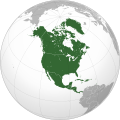Cuba
Coordinates: 22°00′N 80°00′W / 22.000°N 80.000°W / 22.000; -80.000
Republic of Cuba República de Cuba (Spanish) | |
|---|---|
 Flag  Coat of arms | |
Motto: "¡Patria o Muerte, Venceremos!" (Spanish) "Homeland or Death, we shall overcome!"[1] | |
Anthem: La Bayamesa Bayamo Song [2] | |
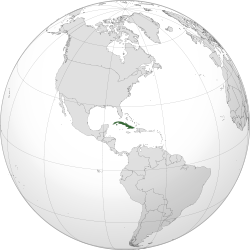 | |
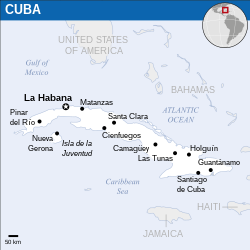 | |
| Capital and largest city | Havana 23°8′N 82°23′W / 23.133°N 82.383°W / 23.133; -82.383 |
| Official languages | Spanish |
Ethnic groups (2012[3]) |
|
| Demonym(s) | Cuban |
| Government | Unitary Marxist–Leninist one-party socialist republic[4] |
• First Secretary of the Communist Party | Raúl Castro |
• President | Miguel Díaz-Canel |
• First Vice President | Salvador Valdés Mesa |
• Second Secretary of the Communist Party | José Machado Ventura |
• President of the National Assembly | Esteban Lazo Hernández |
| Legislature | National Assembly of People's Power |
| Independence | |
• Declaration of Independence | 10 October 1868 |
• War of Independence | 24 February 1895 |
• Recognized (handed over from Spain to the United States) | 10 December 1898 |
• Republic declared (independence from United States) | 20 May 1902 |
• Cuban Revolution | 26 July 1953 – 1 January 1959 |
• Current constitution | 24 February 1976 |
| Area | |
• Total | 109,884 km2 (42,426 sq mi) (104th) |
• Water (%) | 0.94 |
| Population | |
• 2017 census | |
• Density | 102.1/km2 (264.4/sq mi) (114th) |
GDP (PPP) | 2015 estimate |
• Total | US$ 254.865 billion[6] |
• Per capita | US$ 22,237[6][7] |
GDP (nominal) | 2016 estimate |
• Total | US$ 89.689 billion[8] (65th) |
• Per capita | US$ 7,815[9] (77th) |
Gini (2000) | 38.0[10] medium |
HDI (2017) | high · 73th |
| Currency |
|
| Time zone | UTC−5 (CST) |
• Summer (DST) | UTC−4 (CDT) |
| Driving side | right |
| Calling code | +53 |
| ISO 3166 code | CU |
| Internet TLD | .cu |
Website www.cubagob.cu | |
| |
Cuba (/ˈkjuːbə/ (![]() listen); Spanish pronunciation: [ˈkuβa]), officially the Republic of Cuba (Spanish:
listen); Spanish pronunciation: [ˈkuβa]), officially the Republic of Cuba (Spanish: ![]() República de Cuba (help·info)), is a country comprising the island of Cuba as well as Isla de la Juventud and several minor archipelagos. Cuba is located in the northern Caribbean where the Caribbean Sea, Gulf of Mexico and Atlantic Ocean meet. It is east of the Yucatán Peninsula (Mexico), south of both the U.S. state of Florida and the Bahamas, west of Haiti and north of both Jamaica and the Cayman Islands. Havana is the largest city and capital; other major cities include Santiago de Cuba and Camagüey. The area of the Republic of Cuba is 110,860 square kilometres (42,800 sq mi) (109,884 square kilometres (42,426 sq mi) without the territorial waters). The island of Cuba is the largest island in Cuba and in the Caribbean, with an area of 105,006 square kilometres (40,543 sq mi), and the second-most populous after Hispaniola, with over 11 million inhabitants.[12]
República de Cuba (help·info)), is a country comprising the island of Cuba as well as Isla de la Juventud and several minor archipelagos. Cuba is located in the northern Caribbean where the Caribbean Sea, Gulf of Mexico and Atlantic Ocean meet. It is east of the Yucatán Peninsula (Mexico), south of both the U.S. state of Florida and the Bahamas, west of Haiti and north of both Jamaica and the Cayman Islands. Havana is the largest city and capital; other major cities include Santiago de Cuba and Camagüey. The area of the Republic of Cuba is 110,860 square kilometres (42,800 sq mi) (109,884 square kilometres (42,426 sq mi) without the territorial waters). The island of Cuba is the largest island in Cuba and in the Caribbean, with an area of 105,006 square kilometres (40,543 sq mi), and the second-most populous after Hispaniola, with over 11 million inhabitants.[12]
The territory that is now Cuba was inhabited by the Ciboney Taíno people from the 4th millennium BC until Spanish colonisation in the 15th century.[13] From the 15th century, it was a colony of Spain until the Spanish–American War of 1898, when Cuba was occupied by the United States and gained nominal independence as a de facto United States protectorate in 1902. As a fragile republic, in 1940 Cuba attempted to strengthen its democratic system, but mounting political radicalization and social strife culminated in a coup and subsequent dictatorship under Fulgencio Batista in 1952.[14] Open corruption and oppression under Batista's rule led to his ousting in January 1959 by the 26th of July Movement, which afterwards established communist rule under the leadership of Fidel Castro.[15][16][17] Since 1965, the state has been governed by the Communist Party of Cuba. The country was a point of contention during the Cold War between the Soviet Union and the United States, and a nuclear war nearly broke out during the Cuban Missile Crisis of 1962. Cuba is one of few Marxist–Leninist socialist states, where the role of the vanguard Communist Party is enshrined in the Constitution. Independent observers have accused the Cuban government of numerous human rights abuses, including arbitrary imprisonment.[18]
Culturally, Cuba is considered part of Latin America.[19] It is a multiethnic country whose people, culture and customs derive from diverse origins, including the aboriginal Taíno and Ciboney peoples, the long period of Spanish colonialism, the introduction of African slaves and a close relationship with the Soviet Union in the Cold War.
Cuba is a sovereign state and a founding member of the United Nations, the G77, the Non-Aligned Movement, the African, Caribbean and Pacific Group of States, ALBA and Organization of American States. The country is a regional power in Latin America and a middle power in world affairs. It has currently one of the world's only planned economies, and its economy is dominated by the exports of sugar, tobacco, coffee and skilled labor. According to the Human Development Index, Cuba has high human development and is ranked the eighth highest in North America, though 67th in the world.[20] It also ranks highly in some metrics of national performance, including health care and education.[21][22]
Contents
1 Etymology
2 History
2.1 Pre-Columbian era
2.2 Spanish colonization and rule (1492–1898)
2.3 Independence movements
2.4 Republic (1902–59)
2.4.1 First years (1902–1925)
2.4.2 Revolution of 1933–1940
2.4.3 Constitution of 1940
2.5 Revolution and Communist party rule (1959–present)
3 Government and politics
3.1 Administrative divisions
3.2 Human rights
3.3 Foreign relations
3.4 Crime and law enforcement
3.5 Military
4 Economy
4.1 Resources
4.2 Tourism
5 Geography
5.1 Climate
5.2 Biodiversity
6 Demographics
6.1 Ethnoracial groups
6.2 Immigration and emigration
6.3 Religion
6.4 Languages
6.5 Largest cities
7 Media
7.1 Press
7.2 Television
7.3 Internet
8 Culture
8.1 Music
8.2 Cuisine
8.3 Literature
8.4 Dance
8.5 Sports
9 Education
10 Health
11 See also
12 References
13 Bibliography
14 External links
Etymology
Historians believe the name Cuba comes from the Taíno language, however "its exact derivation [is] unknown".[23] The exact meaning of the name is unclear but it may be translated either as 'where fertile land is abundant' (cubao),[24] or 'great place' (coabana).[25] Authors who believe that Christopher Columbus was Portuguese state that Cuba was named by Columbus for the town of Cuba in the district of Beja in Portugal.[26][27]
History
Pre-Columbian era

Monument of Hatuey, an early Taíno chief of Cuba
Before the arrival of the Spanish, Cuba was inhabited by three distinct tribes of indigenous peoples of the Americas. The Taíno (an Arawak people), the Guanahatabey and the Ciboney people.
The ancestors of the Ciboney migrated from the mainland of South America, with the earliest sites dated to 5,000 BP.[28]
The Taíno arrived from Hispanola sometime in the 3rd century A.D. When Columbus arrived they were the dominant culture in Cuba, having an estimated population of 150,000.[28]
The Taíno were farmers, while the Ciboney were farmers as well as fishers and hunter-gatherers.
Spanish colonization and rule (1492–1898)
After first landing on an island then called Guanahani, Bahamas, on 12 October 1492,[29]Christopher Columbus commanded his three ships: La Pinta, La Niña and the Santa María, to land on Cuba's northeastern coast on 28 October 1492.[30] (This was near what is now Bariay, Holguín Province.) Columbus claimed the island for the new Kingdom of Spain[31] and named it Isla Juana after Juan, Prince of Asturias.[32]

Diego Velázquez de Cuéllar, conquistador of Cuba
In 1511, the first Spanish settlement was founded by Diego Velázquez de Cuéllar at Baracoa. Other towns soon followed, including San Cristobal de la Habana, founded in 1515, which later became the capital. The native Taíno were forced to work under the encomienda system,[33] which resembled a feudal system in Medieval Europe.[34] Within a century the indigenous people were virtually wiped out due to multiple factors, primarily Eurasian infectious diseases, to which they had no natural resistance (immunity), aggravated by harsh conditions of the repressive colonial subjugation.[35] In 1529, a measles outbreak in Cuba killed two-thirds of those few natives who had previously survived smallpox.[36][37]
On 18 May 1539, Conquistador Hernando de Soto departed from Havana at the head of some 600 followers into a vast expedition through the Southeastern United States, starting at La Florida, in search of gold, treasure, fame and power.[38] On 1 September 1548, Dr. Gonzalo Perez de Angulo was appointed governor of Cuba. He arrived in Santiago, Cuba on 4 November 1549 and immediately declared the liberty of all natives.[39] He became Cuba's first permanent governor to reside in Havana instead of Santiago, and he built Havana's first church made of masonry.[40] After the French took Havana in 1555, the governor's son, Francisco de Angulo, went to Mexico.[41]
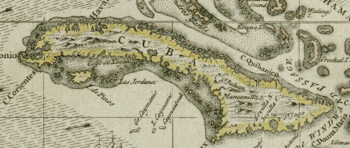
British map of Cuba 1680
Cuba developed slowly and, unlike the plantation islands of the Caribbean, had a diversified agriculture. But what was most important was that the colony developed as an urbanized society that primarily supported the Spanish colonial empire. By the mid-18th century, its colonists held 50,000 slaves, compared to 60,000 in Barbados; 300,000 in Virginia, both British colonies; and 450,000 in French Saint-Domingue, which had large-scale sugar cane plantations.[42]

Map of Cuba by Cornelius Wytfliet in 1597 (National Library of Sweden)
The Seven Years' War, which erupted in 1754 across three continents, eventually arrived in the Spanish Caribbean. Spain's alliance with the French pitched them into direct conflict with the British, and in 1762 a British expedition of five warships and 4,000 troops set out from Portsmouth to capture Cuba. The British arrived on 6 June, and by August had Havana under siege.[43] When Havana surrendered, the admiral of the British fleet, George Keppel, the 3rd Earl of Albemarle, entered the city as a conquering new governor and took control of the whole western part of the island. The British immediately opened up trade with their North American and Caribbean colonies, causing a rapid transformation of Cuban society. They imported food, horses and other goods into the city, as well as thousands of slaves from West Africa to work on the underdeveloped sugar plantations.[43]

The British invasion and occupation of Havana in 1762
Though Havana, which had become the third-largest city in the Americas, was to enter an era of sustained development and increasing ties with North America during this period, the British occupation of the city proved short-lived. Pressure from London sugar merchants, fearing a decline in sugar prices, forced negotiations with the Spanish over colonial territories. Less than a year after Britain seized Havana, it signed the Peace of Paris together with France and Spain, ending the Seven Years' War. The treaty gave Britain Florida in exchange for Cuba. The French had recommended this to Spain, advising that declining to give up Florida could result in Spain instead losing Mexico and much of the South American mainland to the British.[43] Many in Britain were disappointed, believing that Florida was a poor return for Cuba and Britain's other gains in the war.
The real engine for the growth of Cuba's commerce in the late eighteenth and early nineteenth century was the Haitian Revolution. When the enslaved peoples of what had been the Caribbean's richest colony freed themselves through violent revolt, Cuban planters perceived the region's changing circumstances with both a sense of fear and opportunity. They were afraid because of the prospect that slaves might revolt in Cuba, too, and numerous prohibitions during the 1790s on the sale of slaves in Cuba that had previously been slaves in French colonies underscored this anxiety. The planters saw opportunity, however, because they thought that they could exploit the situation by transforming Cuba into the slave society and sugar-producing "pearl of the Antilles" that Haiti had been before the revolution.[44] As the historian Ada Ferrer has written, "At a basic level, liberation in Saint-Domingue helped entrench its denial in Cuba. As slavery and colonialism collapsed in the French colony, the Spanish island underwent transformations that were almost the mirror image of Haiti's."[45] Estimates suggest that between 1790 and 1820 some 325,000 Africans were imported to Cuba as slaves, which was four times the amount that had arrived between 1760 and 1790.[46]

Slaves in Cuba unloading ice from Maine, c. 1832
Although a smaller proportion of the population of Cuba was enslaved, at times slaves arose in revolt. In 1812 the Aponte Slave Rebellion took place but it was suppressed.[47]
The population of Cuba in 1817 was 630,980, of which 291,021 were white, 115,691 free people of color (mixed-race), and 224,268 black slaves.[48] This was a much higher proportion of free blacks to slaves than in Virginia, for instance, or the other Caribbean islands. Historians such as Swedish Magnus Mõrner, who studied slavery in Latin America, found that manumissions increased when slave economies were in decline, as in 18th-century Cuba and early 19th-century Maryland of the United States.[42][49]
In part due to Cuban slaves working primarily in urbanized settings, by the 19th century, there had developed the practice of coartacion, or "buying oneself out of slavery", a "uniquely Cuban development", according to historian Herbert S. Klein.[50] Due to a shortage of white labor, blacks dominated urban industries "to such an extent that when whites in large numbers came to Cuba in the middle of the nineteenth century, they were unable to displace Negro workers."[42] A system of diversified agriculture, with small farms and fewer slaves, served to supply the cities with produce and other goods.[42]
In the 1820s, when the rest of Spain's empire in Latin America rebelled and formed independent states, Cuba remained loyal. Its economy was based on serving the empire.[further explanation needed] By 1860, Cuba had 213,167 free people of color, 39% of its non-white population of 550,000.[42] By contrast, Virginia, with about the same number of blacks, had only 58,042 or 11% who were free; the rest were enslaved.[42] In the antebellum years, after Nat Turner's Slave Rebellion of 1831, Virginia discouraged manumissions and strengthened restrictions against free blacks, as did other Southern states. In addition, there was a high demand for slaves, and Virginia planters sold many in the internal domestic slave trade, who were shipped or taken overland to the Deep South, which had greatly expanded its cotton production.
Independence movements
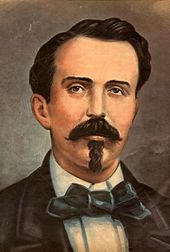
Carlos Manuel de Céspedes is known as Father of the Homeland in Cuba, having declared the nation's independence from Spain in 1868.
Full independence from Spain was the goal of a rebellion in 1868 led by planter Carlos Manuel de Céspedes. De Céspedes, a sugar planter, freed his slaves to fight with him for an independent Cuba. On 27 December 1868, he issued a decree condemning slavery in theory but accepting it in practice and declaring free any slaves whose masters present them for military service.[51] The 1868 rebellion resulted in a prolonged conflict known as the Ten Years' War. Two thousand Cuban Chinese joined the rebels. Chinese had been imported as indentured laborers. A monument in Havana honours the Cuban Chinese who fell in the war.[52]
The United States declined to recognize the new Cuban government, although many European and Latin American nations did so.[53] In 1878, the Pact of Zanjón ended the conflict, with Spain promising greater autonomy to Cuba. In 1879–1880, Cuban patriot Calixto García attempted to start another war known as the Little War but did not receive enough support.[54]Slavery in Cuba was abolished in 1875 but the process was completed only in 1886.[55][56]
An exiled dissident named José Martí founded the Cuban Revolutionary Party in New York in 1892. The aim of the party was to achieve Cuban independence from Spain.[57] In January 1895 Martí traveled to Montecristi and Santo Domingo to join the efforts of Máximo Gómez.[57] Martí recorded his political views in the Manifesto of Montecristi.[58] Fighting against the Spanish army began in Cuba on 24 February 1895, but Martí was unable to reach Cuba until 11 April 1895.[57] Martí was killed in the battle of Dos Rios on 19 May 1895.[57] His death immortalized him as Cuba's national hero.[58]
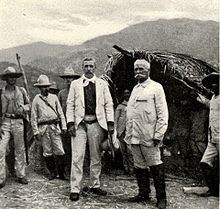
Calixto García, a general of Cuban separatist rebels, (right) with U.S. Brigadier General William Ludlow (Cuba, 1898)
Around 200,000 Spanish troops outnumbered the much smaller rebel army, which relied mostly on guerrilla and sabotage tactics. The Spaniards began a campaign of suppression. General Valeriano Weyler, military governor of Cuba, herded the rural population into what he called reconcentrados, described by international observers as "fortified towns". These are often considered the prototype for 20th-century concentration camps.[59] Between 200,000 and 400,000 Cuban civilians died from starvation and disease in the camps, numbers verified by the Red Cross and United States Senator Redfield Proctor, a former Secretary of War. American and European protests against Spanish conduct on the island followed.[60]
The U.S. battleship Maine was sent to protect U.S. interests, but soon after arrival, it exploded in Havana harbor and sank quickly, killing nearly three quarters of the crew. The cause and responsibility for the sinking of the ship remained unclear after a board of inquiry. Popular opinion in the U.S., fueled by an active press, concluded that the Spanish were to blame and demanded action.[61] Spain and the United States declared war on each other in late April 1898.
Over the previous decades, five U.S. presidents—Polk, Pierce, Buchanan, Grant, and McKinley—had tried to buy the island of Cuba from Spain.[62][63]
Republic (1902–59)
First years (1902–1925)

Raising the Cuban flag on the Governor General's Palace at noon on 20 May 1902
After the Spanish–American War, Spain and the United States signed the Treaty of Paris (1898), by which Spain ceded Puerto Rico, the Philippines, and Guam to the United States for the sum of US$20 million[64] and Cuba became a protectorate of the United States. Cuba gained formal independence from the U.S. on 20 May 1902, as the Republic of Cuba.[65] Under Cuba's new constitution, the U.S. retained the right to intervene in Cuban affairs and to supervise its finances and foreign relations. Under the Platt Amendment, the U.S. leased the Guantánamo Bay Naval Base from Cuba.
Following disputed elections in 1906, the first president, Tomás Estrada Palma, faced an armed revolt by independence war veterans who defeated the meager government forces.[66] The U.S. intervened by occupying Cuba and named Charles Edward Magoon as Governor for three years. Cuban historians have characterized Magoon's governorship as having introduced political and social corruption.[67] In 1908, self-government was restored when José Miguel Gómez was elected President, but the U.S. continued intervening in Cuban affairs. In 1912, the Partido Independiente de Color attempted to establish a separate black republic in Oriente Province,[68] but was suppressed by General Monteagudo with considerable bloodshed.
In 1924, Gerardo Machado was elected president.[69] During his administration, tourism increased markedly, and American-owned hotels and restaurants were built to accommodate the influx of tourists.[69] The tourist boom led to increases in gambling and prostitution in Cuba.[69] The Wall Street Crash of 1929 led to a collapse in the price of sugar, political unrest, and repression.[70] Protesting students, known as the Generation of 1930, turned to violence in opposition to the increasingly unpopular Machado.[70] A general strike (in which the Communist Party sided with Machado),[71] uprisings among sugar workers, and an army revolt forced Machado into exile in August 1933. He was replaced by Carlos Manuel de Céspedes y Quesada.[70]
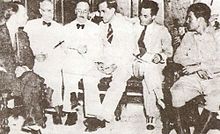
The Pentarchy of 1933. Fulgencio Batista, who controlled the armed forces, appears at far right
Revolution of 1933–1940
In September 1933, the Sergeants' Revolt, led by Sergeant Fulgencio Batista, overthrew Cespedes.[72] A five-member executive committee (the Pentarchy of 1933) was chosen to head a provisional government.[73]Ramón Grau San Martín was then appointed as provisional president.[73] Grau resigned in 1934, leaving the way clear for Batista, who dominated Cuban politics for the next 25 years, at first through a series of puppet-presidents.[72] The period from 1933 to 1937 was a time of "virtually unremitting social and political warfare".[74] On balance, during this period 1933–1940 Cuba is supported by a fragile politic reality that materialize in the decision making of three presidents in two years (1935–1936), as well as in the militaristic and repressive policies of Batista as Head of the Army.
Constitution of 1940
A new constitution was adopted in 1940, which engineered radical progressive ideas, including the right to labour and health care.[75] Batista was elected president in the same year, holding the post until 1944.[76] He is so far the only non-white Cuban to win the nation's highest political office.[77][78][79] His government carried out major social reforms. Several members of the Communist Party held office under his administration.[80] Cuban armed forces were not greatly involved in combat during World War II—though president Batista did suggest a joint U.S.-Latin American assault on Francoist Spain to overthrow its authoritarian regime.[81]
Batista adhered to the 1940 constitution's strictures preventing his re-election.[82] Ramon Grau San Martin was the winner of the next election, in 1944.[76] Grau further corroded the base of the already teetering legitimacy of the Cuban political system, in particular by undermining the deeply flawed, though not entirely ineffectual, Congress and Supreme Court.[83]Carlos Prío Socarrás, a protégé of Grau, became president in 1948.[76] The two terms of the Auténtico Party brought an influx of investment, which fueled an economic boom, raised living standards for all segments of society, and created a middle class in most urban areas.[84]
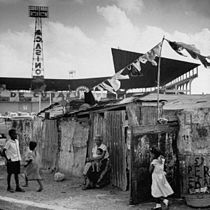
Slum (bohio) dwellings in Havana, Cuba in 1954, just outside Havana baseball stadium. In the background is advertising for a nearby casino.
After finishing his term in 1944 Batista lived in Florida, returning to Cuba to run for president in 1952. Facing certain electoral defeat, he led a military coup that preempted the election.[85] Back in power, and receiving financial, military, and logistical support from the United States government,[86] Batista suspended the 1940 Constitution and revoked most political liberties, including the right to strike. He then aligned with the wealthiest landowners who owned the largest sugar plantations, and presided over a stagnating economy that widened the gap between rich and poor Cubans.[87] Batista outlawed the Cuban Communist Party in 1952.[88] After the coup, Cuba had Latin America's highest per capita consumption rates of meat, vegetables, cereals, automobiles, telephones and radios, though about one third of the population was considered poor and enjoyed relatively little of this consumption.[89]
In 1958, Cuba was a relatively well-advanced country by Latin American standards, and in some cases by world standards.[90] On the other hand, Cuba was affected by perhaps the largest labor union privileges in Latin America, including bans on dismissals and mechanization. They were obtained in large measure "at the cost of the unemployed and the peasants", leading to disparities.[91] Between 1933 and 1958, Cuba extended economic regulations enormously, causing economic problems.[77][92] Unemployment became a problem as graduates entering the workforce could not find jobs.[77] The middle class, which was comparable to that of the United States, became increasingly dissatisfied with unemployment and political persecution. The labor unions supported Batista until the very end.[77][78] Batista stayed in power until he was forced into exile in December 1958.[93]
Revolution and Communist party rule (1959–present)
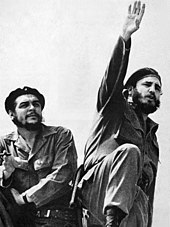
Che Guevara and Fidel Castro, photographed by Alberto Korda in 1961
In the 1950s, various organizations, including some advocating armed uprising, competed for public support in bringing about political change.[94] In 1956, Fidel Castro and about 80 supporters landed from the yacht Granma in an attempt to start a rebellion against the Batista government.[94] It was not until 1958 that Castro's July 26th Movement emerged as the leading revolutionary group.[94]
By late 1958 the rebels had broken out of the Sierra Maestra and launched a general popular insurrection. After Castro's fighters captured Santa Clara, Batista fled with his family to the Dominican Republic on 1 January 1959. Later he went into exile on the Portuguese island of Madeira and finally settled in Estoril, near Lisbon. Fidel Castro's forces entered the capital on 8 January 1959. The liberal Manuel Urrutia Lleó became the provisional president.[95]
From 1959 to 1966 Cuban insurgents fought a six-year rebellion in the Escambray Mountains against the Castro government. The government's vastly superior numbers eventually crushed the insurgency. The rebellion lasted longer and involved more soldiers than the Cuban Revolution.[96][97] The U.S. State Department has estimated that 3,200 people were executed from 1959 to 1962.[98] According to Amnesty International, official death sentences from 1959–87 numbered 237 of which all but 21 were actually carried out.[99] Other estimates for the total number of political executions range from 4,000 to 33,000.[100][101][102] The vast majority of those executed directly following the 1959 revolution were policemen, politicians, and informers of the Batista regime accused of crimes such as torture and murder, and their public trials and executions had widespread popular support among the Cuban population.[103]

Since 1959, Cuba has regarded the U.S. presence in Guantánamo Bay as illegal.[104]
The United States government initially reacted favorably to the Cuban revolution, seeing it as part of a movement to bring democracy to Latin America.[105] Castro's legalization of the Communist party and the hundreds of executions that followed caused a deterioration in the relationship between the two countries.[105] The promulgation of the Agrarian Reform Law, expropriating thousands of acres of farmland (including from large U.S. landholders), further worsened relations.[105][106] In response, between 1960 and 1964 the U.S imposed a range of sanctions, eventually including a total ban on trade between the countries and a freeze on all Cuban-owned assets in the U.S.[107] In February 1960, Castro signed a commercial agreement with Soviet Vice-Premier Anastas Mikoyan.[105]
In March 1960, Eisenhower gave his approval to a CIA plan to arm and train a group of Cuban refugees to overthrow the Castro regime.[108] The invasion (known as the Bay of Pigs Invasion) took place on 14 April 1961.[106] About 1,400 Cuban exiles disembarked at the Bay of Pigs, but failed in their attempt to overthrow Castro.[106]
In January 1962, Cuba was suspended from the Organization of American States (OAS), and later the same year the OAS started to impose sanctions against Cuba of similar nature to the US sanctions.[109] The Cuban Missile Crisis occurred in October 1962. By 1963, Cuba was moving towards a full-fledged Communist system modeled on the USSR.[110]

Fidel Castro and members of the East German Politburo in 1972
During the 1970s, Fidel Castro dispatched tens of thousands of troops in support of Soviet-supported wars in Africa. He supported the MPLA in Angola and Mengistu Haile Mariam in Ethiopia.[111]
The standard of living in the 1970s was "extremely spartan" and discontent was rife.[112] Fidel Castro admitted the failures of economic policies in a 1970 speech.[112] In 1975 the OAS lifted its sanctions against Cuba, with the approval of 16 member states, including the U.S. The U.S., however, maintained its own sanctions.[109]
Castro's rule was severely tested in the aftermath of the Soviet collapse in 1991 (known in Cuba as the Special Period). The country faced a severe economic downturn following the withdrawal of Soviet subsidies worth $4 billion to $6 billion annually, resulting in effects such as food and fuel shortages.[113][114] The government did not accept American donations of food, medicines, and cash until 1993.[113] On 5 August 1994, state security dispersed protesters in a spontaneous protest in Havana.[115]

Fidel Castro with South African president Thabo Mbeki and the Swedish prime minister Göran Persson, 2005
Cuba has since found a new source of aid and support in the People's Republic of China. In addition, Hugo Chávez, former President of Venezuela, and Evo Morales, President of Bolivia, became allies and both countries are major oil and gas exporters. In 2003, the government arrested and imprisoned a large number of civil activists, a period known as the "Black Spring".[116][117]
In February 2008, Fidel Castro announced his resignation as President of Cuba.[118] On 24 February his brother, Raúl Castro, was declared the new President.[119] In his inauguration speech, Raúl promised that some of the restrictions on freedom in Cuba would be removed.[120] In March 2009, Raúl Castro removed some of his brother's appointees.[121]
On 3 June 2009, the Organization of American States adopted a resolution to end the 47-year ban on Cuban membership of the group.[122] The resolution stated, however, that full membership would be delayed until Cuba was "in conformity with the practices, purposes, and principles of the OAS".[109] Fidel Castro restated his position that he was not interested in joining after the OAS resolution had been announced.[123]
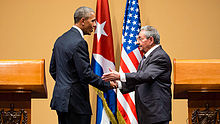
Raúl Castro and U.S. President Barack Obama at their joint press conference in Havana, Cuba, 21 March 2016
Effective 14 January 2013, Cuba ended the requirement established in 1961, that any citizens who wish to travel abroad were required to obtain an expensive government permit and a letter of invitation.[124][125][126] In 1961 the Cuban government had imposed broad restrictions on travel to prevent the mass emigration of people after the 1959 revolution;[127] it approved exit visas only on rare occasions.[128] Requirements were simplified: Cubans need only a passport and a national ID card to leave; and they are allowed to take their young children with them for the first time.[129] However, a passport costs on average five months' salary. Observers expect that Cubans with paying relatives abroad are most likely to be able to take advantage of the new policy.[130] In the first year of the program, over 180,000 left Cuba and returned.[131]
As of December 2014[update], talks with Cuban officials and American officials, including President Barack Obama, resulted in the release of Alan Gross, fifty-two political prisoners, and an unnamed non-citizen agent of the United States in return for the release of three Cuban agents currently imprisoned in the United States. Additionally, while the embargo between the United States and Cuba was not immediately lifted, it was relaxed to allow import, export, and certain limited commerce.[132]
Government and politics

Sign promoting the 2008 parliamentary election
The Republic of Cuba is one of the world's last remaining socialist countries following the Marxist–Leninist ideology. The Constitution of 1976, which defined Cuba as a socialist republic, was replaced by the Constitution of 1992, which is "guided by the ideas of José Martí and the political and social ideas of Marx, Engels and Lenin."[4] The constitution describes the Communist Party of Cuba as the "leading force of society and of the state".[4]
The First Secretary of the Communist Party is concurrently President of the Council of State (President of Cuba) and President of the Council of Ministers (sometimes referred to as Prime Minister of Cuba).[133][needs update] Members of both councils are elected by the National Assembly of People's Power.[4] The President of Cuba, who is also elected by the Assembly, serves for five years and there is no limit to the number of terms of office.[4]

The headquarters of the Communist Party
The People's Supreme Court serves as Cuba's highest judicial branch of government. It is also the court of last resort for all appeals against the decisions of provincial courts.
Cuba's national legislature, the National Assembly of People's Power (Asamblea Nacional de Poder Popular), is the supreme organ of power; 609 members serve five-year terms.[4] The assembly meets twice a year; between sessions legislative power is held by the 31 member Council of Ministers. Candidates for the Assembly are approved by public referendum. All Cuban citizens over 16 who have not been convicted of a criminal offense can vote.[134] Article 131 of the Constitution states that voting shall be "through free, equal and secret vote".[4] Article 136 states: "In order for deputies or delegates to be considered elected they must get more than half the number of valid votes cast in the electoral districts".[4]
No political party is permitted to nominate candidates or campaign on the island, including the Communist Party.[135] The Communist Party of Cuba has held six party congress meetings since 1975. In 2011, the party stated that there were 800,000 members, and representatives generally constitute at least half of the Councils of state and the National Assembly. The remaining positions are filled by candidates nominally without party affiliation. Other political parties campaign and raise finances internationally, while activity within Cuba by opposition groups is minimal.
Cuba is considered an authoritarian regime according to the 2016 Democracy Index[136] and 2017 Freedom in the World survey.[137]
In February 2013, Cuban president Raúl Castro announced he would resign in 2018, ending his five-year term, and that he hopes to implement permanent term limits for future Cuban Presidents, including age limits.[138]
After Fidel Castro died on 25 November 2016, the Cuban government declared a nine-day mourning period. During the mourning period Cuban citizens were prohibited from playing loud music, partying, and drinking alcohol.[139]
Administrative divisions
The country is subdivided into 15 provinces and one special municipality (Isla de la Juventud). These were formerly part of six larger historical provinces: Pinar del Río, Habana, Matanzas, Las Villas, Camagüey and Oriente. The present subdivisions closely resemble those of the Spanish military provinces during the Cuban Wars of Independence, when the most troublesome areas were subdivided. The provinces are divided into municipalities.

Provinces of Cuba
|
|
Human rights
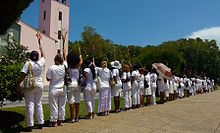
Ladies in White demonstration in Havana (April 2012)
The Cuban government has been accused of numerous human rights abuses including torture, arbitrary imprisonment, unfair trials, and extrajudicial executions (also known as "El Paredón").[140][141]Human Rights Watch has stated that the government "represses nearly all forms of political dissent" and that "Cubans are systematically denied basic rights to free expression, association, assembly, privacy, movement, and due process of law".[142]
In 2003, the European Union (EU) accused the Cuban government of "continuing flagrant violation of human rights and fundamental freedoms".[143] It has continued to call regularly for social and economic reform in Cuba, along with the unconditional release of all political prisoners.[144] The United States continues an embargo against Cuba "so long as it continues to refuse to move toward democratization and greater respect for human rights",[145] though the UN General Assembly has, since 1992, passed a resolution every year condemning the ongoing impact of the embargo and claiming it violates the Charter of the United Nations and international law.[146] Cuba considers the embargo itself a violation of human rights.[147] On 17 December 2014, United States President Barack Obama announced the re-establishment of diplomatic relations with Cuba, pushing for Congress to put an end to the embargo.[148]

Cuban dissidents Antonio Rodiles, Antúnez and Orlando Gutierrez-Boronat in 2017
Cuba had the second-highest number of imprisoned journalists of any nation in 2008 (China had the highest) according to various sources, including the Committee to Protect Journalists and Human Rights Watch.[149][150]
Cuban dissidents face arrest and imprisonment. In the 1990s, Human Rights Watch reported that Cuba's extensive prison system, one of the largest in Latin America, consists of 40 maximum-security prisons, 30 minimum-security prisons, and over 200 work camps.[151] According to Human Rights Watch, Cuba's prison population is confined in "substandard and unhealthy conditions, where prisoners face physical and sexual abuse".[151]
In July 2010, the unofficial Cuban Human Rights Commission said there were 167 political prisoners in Cuba, a fall from 201 at the start of the year. The head of the commission stated that long prison sentences were being replaced by harassment and intimidation.[152] During the entire period of Castro's rule over the island, an estimated 200,000 people had been imprisoned or deprived of their freedoms for political reasons.[16]
Foreign relations
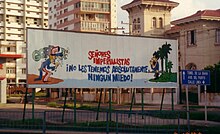
Propaganda sign in front of the United States Interests Section in Havana
Cuba has conducted a foreign policy that is uncharacteristic of such a minor, developing country.[153][154] Under Castro, Cuba was heavily involved in wars in Africa, Central America and Asia. Cuba supported Algeria in 1961–1965,[155] and sent tens of thousands of troops to Angola during the Angolan Civil War.[156] Other countries that featured Cuban involvement include Ethiopia,[157][158]Guinea,[159]Guinea-Bissau,[160]Mozambique,[161] and Yemen.[162] Lesser known actions include the 1959 missions to the Dominican Republic.[163] The expedition failed, but a prominent monument to its members was erected in their memory in Santo Domingo by the Dominican government, and they feature prominently at the country's Memorial Museum of the Resistance.[164]
In 2008, the European Union (EU) and Cuba agreed to resume full relations and cooperation activities.[165] Cuba is a founding member of the Bolivarian Alliance for the Americas.[166] At the end of 2012, tens of thousands of Cuban medical personnel worked abroad,[167] with as many as 30,000 doctors in Venezuela alone via the two countries' oil-for-doctors programme.[168]

Raúl Castro with Mongolian President Elbegdorj during the Moscow Victory Day Parade, 9 May 2015
In 1996, the United States, then under President Bill Clinton, brought in the Cuban Liberty and Democratic Solidarity Act, better known as the Helms–Burton Act.[169] In 2009, United States President Barack Obama stated on April 17, in Trinidad and Tobago that "the United States seeks a new beginning with Cuba",[170] and reversed the Bush Administration's prohibition on travel and remittances by Cuban-Americans from the United States to Cuba.[171] Five years later, an agreement between the United States and Cuba, popularly called "The Cuban Thaw", brokered in part by Canada and Pope Francis, began the process of restoring international relations between the two countries. They agreed to release political prisoners and the United States began the process of creating an embassy in Havana.[172][173][174][175][176] This was realized on 30 June 2015, when Cuba and the U.S. reached a deal to reopen embassies in their respective capitals on 20 July 2015[177] and reestablish diplomatic relations.[178] Earlier in the same year, the White House announced that President Obama would remove Cuba from the American government's list of nations that sponsor terrorism,[179][180] which Cuba reportedly welcomed as "fair".[181] On 17 September 2017, the United States considered closing its Cuban embassy following mysterious sonic attacks on its staff.[182]
Crime and law enforcement
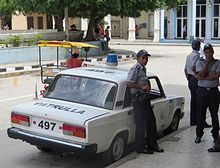
A Lada Riva police car in Holguín
All law enforcement agencies are maintained under Cuba's Ministry of the Interior, which is supervised by the Revolutionary Armed Forces. In Cuba, citizens can receive police assistance by dialing "106" on their telephones.[183] The police force, which is referred to as "Policía Nacional Revolucionaria" or PNR is then expected to provide help. The Cuban government also has an agency called the Intelligence Directorate that conducts intelligence operations and maintains close ties with the Russian Federal Security Service.
Military
As of 2009[update], Cuba spent about US$91.8 million on its armed forces.[184] In 1985, Cuba devoted more than 10% of its GDP to military expenditures.[185] In response to perceived American aggression, such as the Bay of Pigs Invasion, Cuba built up one of the largest armed forces in Latin America, second only to that of Brazil.[186]
From 1975 until the late 1980s, Soviet military assistance enabled Cuba to upgrade its military capabilities. After the loss of Soviet subsidies, Cuba scaled down the numbers of military personnel, from 235,000 in 1994 to about 60,000 in 2003.[187]
Economy

Cuban export composition, 2009
The Cuban state claims to adhere to socialist principles in organizing its largely state-controlled planned economy. Most of the means of production are owned and run by the government and most of the labor force is employed by the state. Recent years have seen a trend toward more private sector employment. By 2006, public sector employment was 78% and private sector 22%, compared to 91.8% to 8.2% in 1981.[188] Government spending is 78.1% of GDP.[189] Any firm that hires a Cuban must pay the Cuban government, which in turn pays the employee in Cuban pesos.[190] The average monthly wage as of July 2013[update] is 466 Cuban pesos—about US$19.[191]
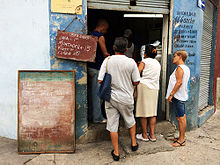
People waiting in line at a libreta store in Havana
Cuba has a dual currency system, whereby most wages and prices are set in Cuban pesos (CUP), while the tourist economy operates with Convertible pesos (CUC), set at par with the US dollar.[191] Every Cuban household has a ration book (known as libreta) entitling it to a monthly supply of food and other staples, which are provided at nominal cost.[192]
Before Fidel Castro's 1959 revolution, Cuba was one of the most advanced and successful countries in Latin America.[193] Cuba's capital, Havana, was a "glittering and dynamic city".[193] The country's economy in the early part of the century, fuelled by the sale of sugar to the United States, had grown wealthy. Cuba ranked 5th in the hemisphere in per capita income, 3rd in life expectancy, 2nd in per capita ownership of automobiles and telephones, and 1st in the number of television sets per inhabitant. Cuba's literacy rate, 76%, was the fourth highest in Latin America. Cuba also ranked 11th in the world in the number of doctors per capita. Several private clinics and hospitals provided services for the poor. Cuba's income distribution compared favorably with that of other Latin American societies. However, income inequality was profound between city and countryside, especially between whites and blacks. Cubans lived in abysmal poverty in the countryside. According to PBS, a thriving middle class held the promise of prosperity and social mobility.[193] According to Cuba historian Louis Perez of the University of North Carolina at Chapel Hill, "Havana was then what Las Vegas has become."[194] In 2016, the Miami Herald wrote, "... about 27 percent of Cubans earn under $50 per month; 34 percent earn the equivalent of $50 to $100 per month; and 20 percent earn $101 to $200. Twelve percent reported earning $201 to $500 a month; and almost 4 percent said their monthly earnings topped $500, including 1.5 percent who said they earned more than $1,000."[195]

Cigar production in Santiago de Cuba
After the Cuban revolution and before the collapse of the Soviet Union, Cuba depended on Moscow for substantial aid and sheltered markets for its exports. The loss of these subsidies sent the Cuban economy into a rapid depression known in Cuba as the Special Period. Cuba took limited free market-oriented measures to alleviate severe shortages of food, consumer goods, and services. These steps included allowing some self-employment in certain retail and light manufacturing sectors, the legalization of the use of the US dollar in business, and the encouragement of tourism. Cuba has developed a unique urban farm system called organopónicos to compensate for the end of food imports from the Soviet Union. The U.S. embargo against Cuba was instituted in response to nationalization of U.S.-citizen-held property and was maintained at the premise of perceived human rights violations. It is widely viewed that the embargo hurt the Cuban economy. In 2009, the Cuban Government estimated this loss at $685 million annually.[196]
Cuba's leadership has called for reforms in the country's agricultural system. In 2008, Raúl Castro began enacting agrarian reforms to boost food production, as at that time 80% of food was imported. The reforms aim to expand land use and increase efficiency.[197] Venezuela supplies Cuba with an estimated 110,000 barrels (17,000 m3) of oil per day in exchange for money and the services of some 44,000 Cubans, most of them medical personnel, in Venezuela.[198][199]
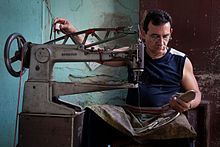
Cubans are now permitted to own small businesses in certain sectors.
In 2005, Cuba had exports of US$2.4 billion, ranking 114 of 226 world countries, and imports of US$6.9 billion, ranking 87 of 226 countries.[200] Its major export partners are Canada 17.7%, China 16.9%, Venezuela 12.5%, Netherlands 9%, and Spain 5.9% (2012).[201] Cuba's major exports are sugar, nickel, tobacco, fish, medical products, citrus fruits, and coffee;[201] imports include food, fuel, clothing, and machinery. Cuba presently holds debt in an amount estimated at $13 billion,[202] approximately 38% of GDP.[203] According to the Heritage Foundation, Cuba is dependent on credit accounts that rotate from country to country.[204] Cuba's prior 35% supply of the world's export market for sugar has declined to 10% due to a variety of factors, including a global sugar commodity price drop that made Cuba less competitive on world markets.[205] It was announced in 2008 that wage caps would be abandoned to improve the nation's productivity.[206]
In 2010[update], Cubans were allowed to build their own houses. According to Raúl Castro, they could now improve their houses, but the government would not endorse these new houses or improvements.[207] There is virtually no homelessness in Cuba, and 85% of Cubans own their homes and pay no property taxes or mortgage interest. Mortgage payments may not exceed 10% of a household's combined income.[196][208]
On 2 August 2011, The New York Times reported that Cuba reaffirmed its intent to legalize "buying and selling" of private property before the year's end. According to experts, the private sale of property could "transform Cuba more than any of the economic reforms announced by President Raúl Castro's government".[209] It would cut more than one million state jobs, including party bureaucrats who resist the changes.[210] The reforms created what some call "New Cuban Economy".[211][212] In October 2013, Raúl said he intended to merge the two currencies, but as of August 2016[update], the dual currency system remains in force.
In August 2012, a specialist of the "Cubaenergia Company" announced the opening of Cuba's first Solar Power Plant. As a member of the Cubasolar Group, there was also a mention of 10 additional plants in 2013.[213]
Resources
Cuba's natural resources include sugar, tobacco, fish, citrus fruits, coffee, beans, rice, potatoes, and livestock. Cuba's most important mineral resource is nickel, with 21% of total exports in 2011.[214] The output of Cuba's nickel mines that year was 71,000 tons, approaching 4% of world production.[215] As of 2013[update] its reserves were estimated at 5.5 million tons, over 7% of the world total.[215]Sherritt International of Canada operates a large nickel mining facility in Moa. Cuba is also a major producer of refined cobalt, a by-product of nickel mining.[216]
Oil exploration in 2005 by the US Geological Survey revealed that the North Cuba Basin could produce about 4.6 billion barrels (730,000,000 m3) to 9.3 billion barrels (1.48×109 m3) of oil. In 2006, Cuba started to test-drill these locations for possible exploitation.[217]
Tourism

Varadero beach
Tourism was initially restricted to enclave resorts where tourists would be segregated from Cuban society, referred to as "enclave tourism" and "tourism apartheid".[218] Contact between foreign visitors and ordinary Cubans were de facto illegal between 1992 and 1997.[219] The rapid growth of tourism during the Special Period had widespread social and economic repercussions in Cuba, and led to speculation about the emergence of a two-tier economy.[220]
Cuba has tripled its market share of Caribbean tourism in the last decade;[when?] as a result of significant investment in tourism infrastructure, this growth rate is predicted to continue.[221]1.9 million tourists visited Cuba in 2003, predominantly from Canada and the European Union, generating revenue of US$2.1 billion.[222] Cuba recorded 2,688,000 international tourists in 2011, the third-highest figure in the Caribbean (behind the Dominican Republic and Puerto Rico).[223]
The medical tourism sector caters to thousands of European, Latin American, Canadian, and American consumers every year.
A recent study indicates that Cuba has a potential for mountaineering activity, and that mountaineering could be a key contributor to tourism, along with other activities, e.g. biking, diving, caving). Promoting these resources could contribute to regional development, prosperity, and well-being.[224]
The Cuban Justice minister downplays allegations of widespread sex tourism.[225] According to a Government of Canada travel advice website, "Cuba is actively working to prevent child sex tourism, and a number of tourists, including Canadians, have been convicted of offences related to the corruption of minors aged 16 and under. Prison sentences range from 7 to 25 years."[226]
Some tourist facilities were extensively damaged on 8 September 2017 when Hurricane Irma hit the island. The storm made landfall in the Camagüey Archipelago; the worst damage was in the keys north of the main island, however, and not in the most significant tourist areas.[227]
Geography
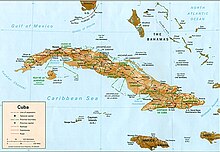
A general map of Cuba
Cuba is an archipelago of islands located in the northern Caribbean Sea at the confluence with the Gulf of Mexico and the Atlantic Ocean. It lies between latitudes 19° and 24°N, and longitudes 74° and 85°W. The United States lies 150 kilometers (93 miles) across the Straits of Florida to the north and northwest (to the closest tip of Key West, Florida), and the Bahamas 21 km (13 mi) to the north. Mexico lies 210 kilometers (130 miles) across the Yucatán Channel to the west (to the closest tip of Cabo Catoche in the State of Quintana Roo).
Haiti is 77 km (48 mi) to the east, Jamaica (140 km/87 mi) and the Cayman Islands to the south. Cuba is the principal island, surrounded by four smaller groups of islands: the Colorados Archipelago on the northwestern coast, the Sabana-Camagüey Archipelago on the north-central Atlantic coast, the Jardines de la Reina on the south-central coast and the Canarreos Archipelago on the southwestern coast.

Sierra Maestra
The main island, named Cuba, is 1,250 km (780 mi) long, constituting most of the nation's land area (104,556 km2 (40,369 sq mi)) and is the largest island in the Caribbean and 17th-largest island in the world by land area. The main island consists mostly of flat to rolling plains apart from the Sierra Maestra mountains in the southeast, whose highest point is Pico Turquino (1,974 m (6,476 ft)).
The second-largest island is Isla de la Juventud (Isle of Youth) in the Canarreos archipelago, with an area of 2,200 km2 (849 sq mi). Cuba has an official area (land area) of 109,884 km2 (42,426 sq mi). Its area is 110,860 km2 (42,803 sq mi) including coastal and territorial waters.
Climate

Viñales Valley
With the entire island south of the Tropic of Cancer, the local climate is tropical, moderated by northeasterly trade winds that blow year-round. The temperature is also shaped by the Caribbean current, which brings in warm water from the equator. This makes the climate of Cuba warmer than that of Hong Kong, which is at around the same latitude as Cuba but has a subtropical rather than a tropical climate. In general (with local variations), there is a drier season from November to April, and a rainier season from May to October. The average temperature is 21 °C (69.8 °F) in January and 27 °C (80.6 °F) in July. The warm temperatures of the Caribbean Sea and the fact that Cuba sits across the entrance to the Gulf of Mexico combine to make the country prone to frequent hurricanes. These are most common in September and October.
Hurricane Irma hit the island on 8 September 2017, with winds of 260 kilometres per hour,[228] at the Camagüey Archipelago; the storm reached Ciego de Avila province around midnight and continued to pound Cuba the next day.[229] The worst damage was in the keys north of the main island. Hospitals, warehouses and factories were damaged; much of the north coast was without electricity. By that time, nearly a million people, including tourists, had been evacuated.[227] The Varadero resort area also reported widespread damage; the government believed that repairs could be completed before the start of the main tourist season.[230] Subsequent reports indicated that 10 people had been killed during the storm, including seven in Havana, most during building collapses. Sections of the capital had been flooded.[230]Hurricane Jose was not expected to strike Cuba.[231]
Biodiversity
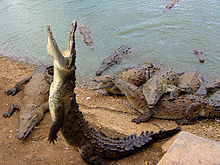
Large group of American crocodiles in Cuba
Cuba signed the Rio Convention on Biological Diversity on 12 June 1992, and became a party to the convention on 8 March 1994.[232] It has subsequently produced a National Biodiversity Strategy and Action Plan, with one revision, that the convention received on 24 January 2008.[233]
The revision comprises an action plan with time limits for each item, and an indication of the governmental body responsible for delivery. That document contains virtually no information about biodiversity. However, the country's fourth national report to the CBD contains a detailed breakdown of the numbers of species of each kingdom of life recorded from Cuba, the main groups being: animals (17,801 species), bacteria (270), chromista (707), fungi, including lichen-forming species (5844), plants (9107) and protozoa (1440).[234]
As elsewhere in the world, vertebrate animals and flowering plants are well documented, so the recorded numbers of species are probably close to the true numbers. For most or all other groups, the true numbers of species occurring in Cuba are likely to exceed, often considerably, the numbers recorded so far.
Demographics
| Population[235] | |||
|---|---|---|---|
| Year | Million | ||
| 1950 | 5.9 | ||
| 2000 | 11.1 | ||
| 2016 | 11.5 | ||

Students of the Escuela Lenin
According to the official census of 2010, Cuba's population was 11,241,161, comprising 5,628,996 men and 5,612,165 women.[236] Its birth rate (9.88 births per thousand population in 2006)[237] is one of the lowest in the Western Hemisphere. Although the country's population has grown by about four million people since 1961, the rate of growth slowed during that period, and the population began to decline in 2006, due in the country's low fertility rate (1.43 children per woman) coupled with emigration.[238]
Indeed, this drop in fertility is among the largest in the Western Hemisphere[239] and is attributed largely to unrestricted access to legal abortion: Cuba's abortion rate was 58.6 per 1000 pregnancies in 1996, compared to an average of 35 in the Caribbean, 27 in Latin America overall, and 48 in Europe. Similarly, the use of contraceptives is also widespread, estimated at 79% of the female population (in the upper third of countries in the Western Hemisphere).[240]
Ethnoracial groups
Cuba's population is multiethnic, reflecting its complex colonial origins. Intermarriage between diverse groups is widespread, and consequently there is some discrepancy in reports of the country's racial composition: whereas the Institute for Cuban and Cuban-American Studies at the University of Miami determined that 62% of Cubans are black,[241] the 2002 Cuban census found that a similar proportion of the population, 65.05%, was white.
In fact, the Minority Rights Group International determined that "An objective assessment of the situation of Afro-Cubans remains problematic due to scant records and a paucity of systematic studies both pre- and post-revolution. Estimates of the percentage of people of African descent in the Cuban population vary enormously, ranging from 34% to 62%".[242]
A 2014 study found that, based on ancestry informative markers (AIM), autosomal genetic ancestry in Cuba is 72% European, 20% African, and 8% Indigenous.[243] Around 35% of maternal lineages derive from Cuban Indigenous People, compared to 39% from Africa and 26% from Europe, but male lineages were European (82%) and African (18%), indicating a historical bias towards mating between foreign men and native women rather than the inverse.[243]
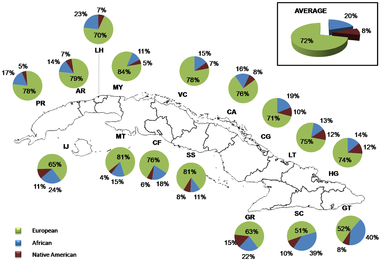
Ancestral contributions in Cubans as inferred from autosomal AIMs.

Ancestral contributions in Cubans as inferred from Y-chromosome markers.
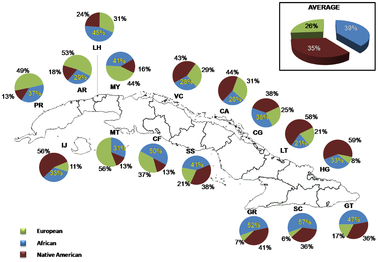
Ancestral contributions in Cubans as inferred from mtDNA markers.
Asians make up about 1% of the population, and are largely of Chinese ancestry, followed by Japanese.[244][245] Many are descendants of farm laborers brought to the island by Spanish and American contractors during the 19th and early 20th century.[246] The current recorded number of Cubans with Chinese ancestry is 114,240.[247]
Afro-Cubans are descended primarily from the Yoruba people, Bantu people from the Congo basin, Carabali people and Arará from the Dahomey[248] as well as several thousand North African refugees, most notably the Sahrawi Arabs of Western Sahara.[249]
Immigration and emigration
Immigration and emigration have played a prominent part in Cuba's demographic profile. Between the 18th and early 20th century, large waves of Canarian, Catalan, Andalusian, Galician, and other Spanish people immigrated to Cuba. Between 1899–1930 alone, close to a million Spaniards entered the country, though many would eventually return to Spain.[250] Other prominent immigrant groups included French,[251]Portuguese, Italian, Russian, Dutch, Greek, British, and Irish, as well as small number of descendants of U.S. citizens who arrived in Cuba in the late 19th and early 20th centuries.
Post-revolution Cuba has been characterized by significant levels of emigration, which has led to a large and influential diaspora community. During the three decades after January 1959, more than one million Cubans of all social classes — constituting 10% of the total population — emigrated to the United States, a proportion that matches the extent of emigration to the U.S. from the Caribbean as a whole during that period.[252][253][254][255][256] Prior to January 13, 2013, Cuban citizens could not travel abroad, leave or return to Cuba without first obtaining official permission along with applying for a government issued passport and travel visa, which was often denied.[257] Other common destinations include Spain, the United Kingdom, Canada, Mexico, and Sweden, among others. Those who left the country typically did so by sea, in small boats and fragile rafts. On 9 September 1994, the U.S. and Cuban governments agreed that the U.S. would grant at least 20,000 visas annually in exchange for Cuba's pledge to prevent further unlawful departures on boats.[258]
Religion

Havana Cathedral
In 2010, the Pew Forum estimated that religious affiliation in Cuba is 65% Christian (60% Roman Catholic or about 6.9 million in 2016, 5% Protestant or about 575,000 in 2016), 23% unaffiliated, 17% folk religion (such as santería), and the remaining 0.4% consisting of other religions.[259]
Cuba is officially a secular state. Religious freedom increased through the 1980s,[260] with the government amending the constitution in 1992 to drop the state's characterization as atheistic.[261]
Roman Catholicism is the largest religion, with its origins in Spanish colonization. Despite less than half of the population identifying as Catholics in 2006, it nonetheless remains the dominant faith.[204] Pope John Paul II and Pope Benedict XVI visited Cuba in 1998 and 2011, respectively, and Pope Francis visited Cuba in September 2015.[262][263] Prior to each papal visit, the Cuban government pardoned prisoners as a humanitarian gesture.[264][265]
The government's relaxation of restrictions on house churches in the 1990s led to an explosion of Pentecostalism, with some groups claiming as many as 100,000 members. However, Evangelical Protestant denominations, organized into the umbrella Cuban Council of Churches, remain much more vibrant and powerful.[266]
The religious landscape of Cuba is also strongly defined by syncretisms of various kinds. Christianity is often practiced in tandem with Santería, a mixture of Catholicism and mostly African faiths, which include a number of cults. La Virgen de la Caridad del Cobre (the Virgin of Cobre) is the Catholic patroness of Cuba, and a symbol of Cuban culture. In Santería, she has been syncretized with the goddess Oshun.
Cuba also hosts small communities of Jews (500 in 2012), Muslims, and members of the Bahá'í Faith.[267]
Several well-known Cuban religious figures have operated outside the island, including the humanitarian and author Jorge Armando Pérez.
Languages
The official language of Cuba is Spanish and the vast majority of Cubans speak it. Spanish as spoken in Cuba is known as Cuban Spanish and is a form of Caribbean Spanish. Lucumí, a dialect of the West African language Yoruba, is also used as a liturgical language by practitioners of Santería,[268] and so only as a second language.[269]Haitian Creole is the second most spoken language in Cuba, and is spoken by Haitian immigrants and their descendants.[270] Other languages spoken by immigrants include Galician and Corsican.[271]
Largest cities
Largest cities or towns in Cuba According to the 2016 Estimate | |||||||||
|---|---|---|---|---|---|---|---|---|---|
| Rank | Name | Province | Pop. | ||||||
 Havana  Santiago de Cuba | 1 | Havana | Havana | 2,130,081 |  Camagüey  Holguín | ||||
| 2 | Santiago de Cuba | Santiago de Cuba | 433,099 | ||||||
| 3 | Camagüey | Camagüey | 306,183 | ||||||
| 4 | Holguín | Holguín | 294,002 | ||||||
| 5 | Guantánamo | Villa Clara | 216,056 | ||||||
| 6 | Santa Clara | Guantánamo | 216,609 | ||||||
| 7 | Victoria de Las Tunas | Granma | 158,978 | ||||||
| 8 | Bayamo | Las Tunas | 168,645 | ||||||
| 9 | Cienfuegos | Cienfuegos | 150,404 | ||||||
| 10 | Pinar del Río | Pinar del Río | 142,967 | ||||||
Media
The Cuban government and Communist Party of Cuba control almost all media in Cuba.
Press
Granma brings:
- Reflections of Fidel Castro
- Speeches of Raúl Castro
Television
Five Communist controlled national channels:
- Cubavisión
- Tele Rebelde
- Canal Educativo
- Canal Educativo 2
- Multivisión
Internet
Internet in Cuba has some of the lowest penetration rates in the Western hemisphere, and all content is subject to review by the Department of Revolutionary Orientation.[272]ETECSA operates 118 cybercafes in the country.[272] The government of Cuba provides an online encyclopedia website called EcuRed that operates in a "wiki" format.[273] Internet access is limited.[274] The sale of computer equipment is strictly regulated. Internet access is controlled, and e-mail is closely monitored.[275]
Culture

A local musical house, Casa de la Trova in Santiago de Cuba
Cuban culture is influenced by its melting pot of cultures, primarily those of Spain and Africa. After the 1959 revolution, the government started a national literacy campaign, offered free education to all and established rigorous sports, ballet and music programs.[276]
Music
@media all and (max-width:720px).mw-parser-output .tmulti>.thumbinnerwidth:100%!important;max-width:none!important.mw-parser-output .tmulti .tsinglefloat:none!important;max-width:none!important;width:100%!important;text-align:center

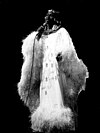
Gloria Estefan and Celia Cruz
Cuban music is very rich and is the most commonly known expression of Cuban culture. The central form of this music is Son, which has been the basis of many other musical styles like "Danzón de nuevo ritmo", mambo, cha-cha-chá and salsa music. Rumba ("de cajón o de solar") music originated in the early Afro-Cuban culture, mixed with Hispanic elements of style.[277] The Tres was invented in Cuba from Hispanic cordophone instruments models (the instrument is actually a fusion of elements from the Spanish guitar and lute). Other traditional Cuban instruments are of African origin, Taíno origin, or both, such as the maracas, güiro, marímbula and various wooden drums including the mayohuacán.
Popular Cuban music of all styles has been enjoyed and praised widely across the world. Cuban classical music, which includes music with strong African and European influences, and features symphonic works as well as music for soloists, has received international acclaim thanks to composers like Ernesto Lecuona. Havana was the heart of the rap scene in Cuba when it began in the 1990s.
During that time, reggaetón grew in popularity. In 2011, the Cuban state denounced reggaeton as degenerate, directed reduced "low-profile" airplay of the genre (but did not ban it entirely) and banned the megahit Chupi Chupi by Osmani García, characterizing its description of sex as "the sort which a prostitute would carry out."[278] In December 2012, the Cuban government officially banned sexually explicit reggaeton songs and music videos from radio and television.[279][280]
As well as pop, classical and rock are very popular in Cuba.
Cuisine
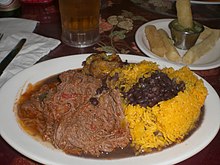
A traditional meal of ropa vieja (shredded flank steak in a tomato sauce base), black beans, yellow rice, plantains and fried yuca with beer
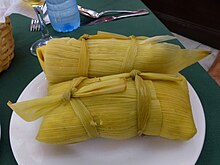
Cuban-style tamales
Cuban cuisine is a fusion of Spanish and Caribbean cuisines. Cuban recipes share spices and techniques with Spanish cooking, with some Caribbean influence in spice and flavor. Food rationing, which has been the norm in Cuba for the last four decades, restricts the common availability of these dishes.[281] The traditional Cuban meal is not served in courses; all food items are served at the same time.
The typical meal could consist of plantains, black beans and rice, ropa vieja (shredded beef), Cuban bread, pork with onions, and tropical fruits. Black beans and rice, referred to as moros y cristianos (or moros for short), and plantains are staples of the Cuban diet. Many of the meat dishes are cooked slowly with light sauces. Garlic, cumin, oregano, and bay leaves are the dominant spices.
Literature
Cuban literature began to find its voice in the early 19th century. Dominant themes of independence and freedom were exemplified by José Martí, who led the Modernist movement in Cuban literature. Writers such as Nicolás Guillén and José Z. Tallet focused on literature as social protest. The poetry and novels of Dulce María Loynaz and José Lezama Lima have been influential. Romanticist Miguel Barnet, who wrote Everyone Dreamed of Cuba, reflects a more melancholy Cuba.[282]
Alejo Carpentier was important in the Magic realism movement. Writers such as Reinaldo Arenas, Guillermo Cabrera Infante, and more recently Daína Chaviano, Pedro Juan Gutiérrez, Zoé Valdés, Guillermo Rosales and Leonardo Padura have earned international recognition in the post-revolutionary era, though many of these writers have felt compelled to continue their work in exile due to ideological control of media by the Cuban authorities.
Dance
Dance holds a privileged position in Cuban culture. Popular dance is considered an essential part of life, and concert dance is supported by the government and includes internationally renowned companies such as the Ballet Nacional de Cuba.[283]
Sports

Cuban former boxer Teófilo Stevenson, widely considered one of the greatest boxers of all time
Due to historical associations with the United States, many Cubans participate in sports that are popular in North America, rather than sports traditionally played in other Latin American nations. Baseball is the most popular. Other sports and pastimes include football, basketball, volleyball, cricket, and athletics. Cuba is a dominant force in amateur boxing, consistently achieving high medal tallies in major international competitions. Cuban boxers are not permitted to turn professional by their government. However, many boxers defect to the U.S. and other countries.[284][285] Cuba also provides a national team that competes in the Olympic Games.[286]
Education

University of Havana, founded in 1728
The University of Havana was founded in 1728 and there are a number of other well-established colleges and universities. In 1957, just before Castro came to power, the literacy rate was fourth in the region at almost 80% according to the United Nations, higher than in Spain.[90][287] Castro created an entirely state-operated system and banned private institutions. School attendance is compulsory from ages six to the end of basic secondary education (normally at age 15), and all students, regardless of age or gender, wear school uniforms with the color denoting grade level. Primary education lasts for six years, secondary education is divided into basic and pre-university education.[288] Cuba's literacy rate of 99.8 percent[201][289] is the tenth-highest globally, due largely to the provision of free education at every level.[290] Cuba's high school graduation rate is 94 percent.[291]
Higher education is provided by universities, higher institutes, higher pedagogical institutes, and higher polytechnic institutes. The Cuban Ministry of Higher Education operates a distance education program that provides regular afternoon and evening courses in rural areas for agricultural workers. Education has a strong political and ideological emphasis, and students progressing to higher education are expected to have a commitment to the goals of Cuba.[288] Cuba has provided state subsidized education to a limited number of foreign nationals at the Latin American School of Medicine.[292][293]
According to the Webometrics Ranking of World Universities, the top-ranking universities in the country are Universidad de la Habana (1680th worldwide), Instituto Superior Politécnico José Antonio Echeverría (2893rd) and the University of Santiago de Cuba (3831st).[294]
Health
Cuba's life expectancy at birth is 78.3 years (76.2 for males and 80.4 for females).[201] This ranks Cuba 55th in the world and 5th in the Americas, behind Canada, Chile, Costa Rica and the United States. Infant mortality declined from 32 infant deaths per 1,000 live births in 1957, to 10 in 1990–95,[295] 6.1 in 2000–2005 and 5.13 in 2009.[289][201] Historically, Cuba has ranked high in numbers of medical personnel and has made significant contributions to world health since the 19th century.[90] Today, Cuba has universal health care and despite persistent shortages of medical supplies, there is no shortage of medical personnel.[296] Primary care is available throughout the island and infant and maternal mortality rates compare favorably with those in developed nations.[296] That a developing nation like Cuba has health outcomes rivaling the developed world is referred to by researchers as the Cuban Health Paradox.[297]
Disease and infant mortality increased in the 1960s immediately after the revolution, when half of Cuba's 6,000 doctors left the country.[298] Recovery occurred by the 1980s,[78] and the country's health care has been widely praised.[299] The Communist government asserted that universal health care was a priority of state planning and progress was made in rural areas.[300] Like the rest of the Cuban economy, medical care suffered from severe material shortages following the end of Soviet subsidies in 1991, and a tightening of the U.S. embargo in 1992.[301]
Challenges include low salaries for doctors,[302] poor facilities, poor provision of equipment, and the frequent absence of essential drugs.[303] Cuba has the highest doctor-to-population ratio in the world and has sent thousands of doctors to more than 40 countries around the world.[304] According to the World Health Organization, Cuba is "known the world over for its ability to train excellent doctors and nurses who can then go out to help other countries in need". As of September 2014[update], there are around 50,000 Cuban-trained health care workers aiding 66 nations.[305] Cuban physicians have played a leading role in combating the Ebola virus epidemic in West Africa.[306]
Import and export of pharmaceutical drugs is done by the Quimefa Pharmaceutical Business Group (FARMACUBA) under the Ministry of Basic Industry (MINBAS). This group also provides technical information for the production of these drugs.[307] Isolated from the West by the US embargo, Cuba developed the successful lung cancer vaccine, Cimavax, which is now available to US researchers for the first time, along with other novel Cuban cancer treatments. The vaccine has been available for free to the Cuban population since 2011.[308] According to Roswell Park Cancer Institute CEO Candace Johnson: "They've had to do more with less, so they've had to be even more innovative with how they approach things. For over 40 years, they have had a preeminent immunology community."[309] During the thaw in Cuba–U.S. relations starting in December 2014 under the Obama administration, a growing number of U.S. lung cancer patients traveled to Cuba to receive vaccine treatment. The end of the thaw under the Trump Administrarion has resulted in a tightening of travel restrictions, making it harder for U.S. citizens to travel to Cuba for treatment.[310]
In 2015, Cuba became the first country to eradicate mother-to-child transmission of HIV and syphilis,[311] a milestone hailed by the World Health Organization as "one of the greatest public health achievements possible".[312]
See also
- Index of Cuba-related articles
- Outline of Cuba
References
^ "Cuban Peso Bills". Central Bank of Cuba. 2015. Retrieved February 14, 2017..mw-parser-output cite.citationfont-style:inherit.mw-parser-output qquotes:"""""""'""'".mw-parser-output code.cs1-codecolor:inherit;background:inherit;border:inherit;padding:inherit.mw-parser-output .cs1-lock-free abackground:url("//upload.wikimedia.org/wikipedia/commons/thumb/6/65/Lock-green.svg/9px-Lock-green.svg.png")no-repeat;background-position:right .1em center.mw-parser-output .cs1-lock-limited a,.mw-parser-output .cs1-lock-registration abackground:url("//upload.wikimedia.org/wikipedia/commons/thumb/d/d6/Lock-gray-alt-2.svg/9px-Lock-gray-alt-2.svg.png")no-repeat;background-position:right .1em center.mw-parser-output .cs1-lock-subscription abackground:url("//upload.wikimedia.org/wikipedia/commons/thumb/a/aa/Lock-red-alt-2.svg/9px-Lock-red-alt-2.svg.png")no-repeat;background-position:right .1em center.mw-parser-output .cs1-subscription,.mw-parser-output .cs1-registrationcolor:#555.mw-parser-output .cs1-subscription span,.mw-parser-output .cs1-registration spanborder-bottom:1px dotted;cursor:help.mw-parser-output .cs1-hidden-errordisplay:none;font-size:100%.mw-parser-output .cs1-visible-errorfont-size:100%.mw-parser-output .cs1-subscription,.mw-parser-output .cs1-registration,.mw-parser-output .cs1-formatfont-size:95%.mw-parser-output .cs1-kern-left,.mw-parser-output .cs1-kern-wl-leftpadding-left:0.2em.mw-parser-output .cs1-kern-right,.mw-parser-output .cs1-kern-wl-rightpadding-right:0.2em
^ "National symbols". Government of Cuba. Retrieved September 7, 2009.
^ ab official 2012 Census Archived June 3, 2014, at the Wayback Machine.
^ abcdefgh "The Constitution of the Republic of Cuba, 1976 (as Amended to 2002)" (PDF). National Assembly of People's Power. Archived from the original (PDF) on January 17, 2013. Retrieved August 18, 2012.
For discussion of the 1992 amendments, see Domínguez 2003.
^ "Resumen del Balance Demográfico" (PDF). Archived from the original (PDF) on 31 July 2017. Retrieved 15 July 2017.
^ ab "World Bank GDP PPP 2015, 28 April 2017 PDF". Retrieved 18 January 2018.
^ "World Bank total population of Cuba in 2015 (GDP PPP divided by Population data)". Retrieved 18 January 2018.
^ "GDP (current US$)".
^ "GDP per capita (current US$)".
^ "Cuba grapples with growing inequality". Reuters. Retrieved July 21, 2013.
^ "Table 2: Trends in the Human Development Index, 1990–2014". United Nations Development Programme. Retrieved December 15, 2015.
^ "Cuba profile: Facts". BBC News. Retrieved March 26, 2013.
^ Allaire, p. 678
^ "Remarks of Senator John F. Kennedy at Democratic Dinner, Cincinnati, Ohio". John F. Kennedy Presidential Library & Museum – Jfklibrary.org. October 6, 1960. Retrieved February 14, 2017.
^ "Fidel Castro". Encyclopædia Britannica. 26 June 2017.Castro created a one-party government to exercise dictatorial control over all aspects of Cuba's political, economic, and cultural life. All political dissent and opposition were ruthlessly suppressed
^ ab Fernández, Gonzalo (2009). Cuba's Primer – Castro's Earring Economy. ISBN 9780557065738.The number of individuals who have been jailed or deprived of their freedom in labor camps over the 50 years of Castro's dictatorship is estimated at around 200,000
^ "Fidel Castro – Cuba's hero and dictator". Deutsche Welle. 26 November 2016.
^ "World Report 2018: Rights Trends in Cuba". Human Rights Watch. 2018-01-18. Retrieved 2018-07-15.
^ Rangel, Carlos (1977). The Latin Americans: Their Love-Hate Relationship with the United States. New York: Harcourt Brace Jovanovich. pp. 3–5. ISBN 978-0-15-148795-0.
Skidmore, Thomas E.; Peter H. Smith (2005). Modern Latin America (6 ed.). Oxford and New York: Oxford University Press. pp. 1–10. ISBN 978-0-19-517013-9.
^ "Human Development Report 2015 – "Rethinking Work for Human Development"" (PDF). HDRO (Human Development Report Office) United Nations Development Programme.
^ "GHO – By category – Life expectancy – Data by country".
^ Field Listing: Literacy Archived November 24, 2016, at the Wayback Machine.. CIA World Factbook.
^ "Cuba – Cultural institutions | history – geography". Encyclopedia Britannica. p. 11. Retrieved 18 August 2017.
^ The Dictionary of the Taino Language (plate 8) Alfred Carrada Archived 19 February 2009 at the Wayback Machine.[unreliable source?]
^ Dictionary – Taino indigenous peoples of the Caribbean Dictionary -- Archived April 30, 2008, at the Wayback Machine.[unreliable source?]
^ Augusto Mascarenhas Barreto: O Português. Cristóvão Colombo Agente Secreto do Rei Dom João II. Ed. Referendo, Lissabon 1988. English: The Portuguese Columbus: secret agent of King John II, Palgrave Macmillan,
ISBN 0-333-56315-8
^ da Silva, Manuel L. and Silvia Jorge da Silva. (2008). Christopher Columbus was Portuguese, Express Printing, Fall River, MA. 396pp.
ISBN 978-1-60702-824-6.
^ ab Ramón Dacal Moure, Manuel Rivero de la Calle (1996). Art and archaeology of pre-Columbian Cuba. University of Pittsburgh Press. p. 22. ISBN 978-0-8229-3955-9.
^ Ted Henken (2008). Cuba: a global studies handbook. ABC-CLIO. p. 30. ISBN 978-1-85109-984-9. (gives the landing date in Cuba as 27 October)
^ Cuba Oficina Del Censo (2009). Cuba: Population, History and Resources 1907. BiblioBazaar, LLC. p. 28. ISBN 978-1-110-28818-2. (gives the landing date in Cuba as 28 October)
^ Gott 2004, p. 13
^ Andrea, Alfred J.; Overfield, James H. (2005). "Letter by Christopher Columbus concerning recently discovered islands". The Human Record. 1. Houghton Mifflin Company. p. 8. ISBN 978-0-618-37040-5.
^ "Encomienda or Slavery? The Spanish Crown's Choice of Labor Organization in Sixteenth-Century Spanish America" (PDF). Latin American Studies. Retrieved July 19, 2013.
^ McAlister 1984, p. 164
^ Diamond, Jared M. (1998). Guns, Germs, and Steel: The Fates of Human Societies. New York, NY: W.W. Norton & Co. ISBN 978-0-393-03891-0.
^ Byrne, Joseph Patrick (2008). Encyclopedia of Pestilence, Pandemics, and Plagues: A-M. ABC-CLIO. p. 413. ISBN 978-0-313-34102-1.
^ J. N. Hays (2005). Epidemics and Pandemics: Their Impacts on Human History Archived November 27, 2016, at the Wayback Machine.. p.82.
ISBN 1-85109-658-2
^ Davidson, James West. After the Fact: The Art of Historical Detection Volume 1. Mc Graw Hill, New York 2010, Chapter 1, p. 1
^ Wright 1916, p. 183.
^ Wright 1916, p. 229.
^ Wright 1916, p. 246.
^ abcdef Melvin Drimmer, "Reviewed Work: Slavery in the Americas: A Comparative Study of Virginia and Cuba by Herbert S. Klein", The William and Mary Quarterly Vol. 25, No. 2 (Apr. 1968), pp. 307–309, in JSTOR, accessed 1 March 2015
^ abc Thomas, Hugh. Cuba: The Pursuit of Freedom (2nd edition). Chapter One.
^ Ferrer, Ada (2014). Freedom's Mirror: Cuba and Haiti in the Age of Revolution. New York: Cambridge University Press. p. 5. ISBN 978-1107029422.
^ Ferrer, Ada (2014). Freedom's Mirror: Cuba and Haiti in the Age of Revolution. New York: Cambridge University Press. p. 10. ISBN 978-1107029422.
^ Ferrer, Ada (2014). Freedom's Mirror: Cuba and Haiti in the Age of Revolution. New York: Cambridge University Press. p. 36.
^ Childs, Matt D. (2006). The 1813 Aponte Rebellion in Cuba and the Struggle against Atlantic Slavery. The University of North Carolina Press. p. 320 pages. ISBN 978-0-8078-5772-4.
^ Scheina 2003, p. 352.
^ Magnus Mõrner, Race Mixture in Latin America, Boston, 1967, pp. 124–125
^ Herbert S. Klein, Slavery in the Americas: A Comparative Study of Virginia and Cuba, Chicago: University of Chicago Press, 1967, p. 196
^ Chomsky, Carr & Smorkaloff 2004, pp. 115–7.
^ Westad 2012, pp. 227–8
^ "Historia de las Guerras de Liberación de Cuba".
[unreliable source?]
^ "The Little War (La Guerra Chiquita)".
[unreliable source?]
^ Scott 2000, p. 3
^ Chomsky, Carr & Smorkaloff 2004, pp. 37–8.
^ abcd Stanley Sandler, ed. (2002). Ground warfare: an international encyclopedia. Part 25, Volume 1. ABC-CLIO. p. 549. ISBN 978-1-57607-344-5. Retrieved September 6, 2009.
^ ab David Arias (2005). Spanish-americans: Lives And Faces. Victoria, BC, Canada: Trafford Publishing. p. 171. ISBN 978-1-4120-4717-3. Retrieved September 6, 2009.
^ Robert K. Home (1997). Of Planting and Planning: The Making of British Colonial Cities. Chapman and Hall. p. 195. ISBN 978-0-419-20230-1. Retrieved September 6, 2009.
^ The Spanish–American War. "Cuban Reconcentration Policy and its Effects". Retrieved January 29, 2007.
[unreliable source?]
^ Morison, Samuel Loring; Morison, Samuel Eliot; Polmar, Norman (2003). The American Battleship. St. Paul, Minn.: MBI Publishing Company. p. 18. ISBN 978-0-7603-0989-6. Retrieved September 15, 2009.
^ Falk 1988, p. 64.
^ "Franklin Pierce: Foreign Affairs—Miller Center". Archived from the original on March 12, 2016.
^ "Treaty of Peace Between the United States and Spain". The Avalon Project. Yale Law School. December 10, 1898.
^ Louis A. Pérez (1998). Cuba Between Empires: 1878–1902. University of Pittsburgh Pre. p. xv. ISBN 978-0-8229-7197-9. Retrieved July 19, 2013.
^ Diaz-Briquets, Sergio; Jorge F Pérez-López (2006). Corruption in Cuba: Castro and Beyond. Austin: University of Texas Press. p. 63. ISBN 978-0-292-71321-5. Retrieved September 6, 2009.
^ Thomas 1998, pp. 283–7.
^ Benjamin Beede, ed. (1994). The War of 1898, and U.S. interventions, 1898–1934: an encyclopedia. New York: Garland. p. 134. ISBN 978-0-8240-5624-7. Retrieved September 6, 2009.
^ abc Terry K Sanderlin, Ed D (April 24, 2012). The Last American Rebel in Cuba. AuthorHouse. p. 7. ISBN 978-1-4685-9430-0. Retrieved July 19, 2013.
^ abc Wilber Albert Chaffee; Gary Prevost (1992). Cuba: A Different America. Rowman & Littlefield. p. 4. ISBN 978-0-8476-7694-1. Retrieved July 19, 2013.
^ Argote-Freyre, Frank (2006). Fulgencio Batista. 1. New Brunswick, N.J.: Rutgers University Press. p. 50. ISBN 978-0-8135-3701-6.
^ ab Jones, Melanie (2001). Jacqueline West, ed. South America, Central America and the Caribbean 2002. Routledge. p. 303. ISBN 978-1-85743-121-6. Retrieved July 19, 2013.
^ ab Jaime Suchlicki (2002). Cuba: From Columbus to Castro and Beyond. Potomac Books, Inc. p. 95. ISBN 978-1-57488-436-4. Retrieved July 19, 2013.
^ Domínguez 1978, p. 76
^ Domínguez 1978, p. ?.
^ abc Frank R. Villafana (December 31, 2011). Expansionism: Its Effects on Cuba's Independence. Transaction Publishers. p. 201. ISBN 978-1-4128-4656-1. Retrieved July 19, 2013.
^ abcd Horowitz 1988, p. 662
^ abc Bethell, Leslie (1993). Cuba. Cambridge University Press. ISBN 978-0-521-43682-3.
^ Sweig 2004, p. 4
^ Sweig 2004, p. ?.
^ "Batista's Boot". Time. January 18, 1943. Retrieved April 20, 2013.
^ Domínguez 1978, p. 101
^ Domínguez 1978, pp. 110–1
^ Alvarez 2004.
^ "A Coup in Cuba - History Today". www.historytoday.com.
^ Guerra, Lillian (2010). Grandin, Greg; Joseph, Gilbert M., eds. Beyond Paradox. A Century of Revolution. American Encounters/Global Interactions. Durham, NC: Duke University Press. pp. 199–238. ISBN 978-0-8223-4737-8.
^ Historical Dictionary of the 1950s, by James Stuart Olson, Greenwood Publishing Group, 2000,
ISBN 0-313-30619-2, pp. 67–68.
^ Sweig 2004, p. 6
^ Paul H. Lewis (2006). Authoritarian Regimes in Latin America. Oxford, UK: Rowman & Littlefield. p. 186. ISBN 978-0-7425-3739-2. Retrieved September 14, 2009.
^ abc Smith & Llorens 1998.
^ Baklanoff 1998.
^ Thomas 1998, p. 1173.
^ Maureen Ihrie; Salvador Oropesa (October 31, 2011). World Literature in Spanish: An Encyclopedia: An Encyclopedia. ABC-CLIO. p. 262. ISBN 978-0-313-08083-8. Retrieved July 19, 2013.
^ abc Aviva Chomsky (November 23, 2010). A History of the Cuban Revolution. John Wiley & Sons. pp. 37–38. ISBN 978-1-4443-2956-8. Retrieved July 19, 2013.
^ Falk 1988, p. 67.
^ Ros (2006) pp. 159–201.
^ "Anti-Cuba Bandits: terrorism in past tense". Archived from the original on February 22, 2007.
^ "Background Note: Cuba". State.gov. June 21, 2012. Retrieved July 19, 2013.
^ When the State Kills: The Death Penalty v. Human Rights, Amnesty International Publications, 1989
^ "Cuba or the Pursuit of Freedom Hugh Thomas". Longitudebooks.com. Archived from the original on 7 June 2013. Retrieved 19 July 2013.
^ R.J. Rummel. "Power Kills". University of Hawaii. Retrieved July 19, 2013.
^ Black Book of Communism. p. 664.
^ Chase, Michelle (2010). "The Trials". In Greg Grandin; Joseph Gilbert. A Century of Revolution. Durham, NC: Duke University Press. pp. 163–198. ISBN 978-0822347378. Retrieved September 17, 2015.
^ "US rejects Cuba demand to hand back Guantanamo Bay base Archived December 7, 2016, at the Wayback Machine.". BBC News. 30 January 2015.
^ abcd Stephen G. Rabe (1988). Eisenhower and Latin America: The Foreign Policy of Anticommunism. UNC Press Books. pp. 123–125. ISBN 978-0-8078-4204-1. Retrieved July 19, 2013.
^ abc Richard A. Crooker (2005). Cuba. Infobase Publishing. pp. 43–44. ISBN 978-1-4381-0497-3. Retrieved July 19, 2013.
^ U.S International Trade Commission. The Economic Impact of U.S. Sanctions with Respect to Cuba. p. Section 2–3, p. 2. ISBN 978-1-4578-2290-2.
^ "This Day in History — 7/9/1960". History.com. Retrieved July 19, 2013.
^ abc "Case Studies in Sanctions and Terrorism: Case 60-3, US v. Cuba (1960– : Castro)" (PDF). Peterson Institute for International Economics. October 2011. Retrieved February 14, 2017.
^ Faria, Miguel A. Cuba in Revolution – Escape From a Lost Paradise, 2002, Hacienda Publishing, Inc., Macon, Georgia, pp. 163–228
^ Domínguez 1989, p. ?.
^ ab Bethell, Leslie (1998-08-13). The Cambridge History of Latin America. ISBN 978-0-521-62327-8.
[page needed]
^ ab "Health consequences of Cuba's Special Period". CMAJ : Canadian Medical Association Journal. 179 (3): 257. 2008. doi:10.1503/cmaj.1080068. PMC 2474886. PMID 18663207.
^ Patricia Maroday (January 12, 2015). "Doing Business with Cuba – The Complete Guide". Archived from the original on March 14, 2016.
^ Gershman & Gutierrez 2009, p. ?.
^ Carlos Lauria; Monica Campbell; María Salazar (March 18, 2008). "Cuba's Long Black Spring". The Committee to Protect Journalists.
^ "Cuba – No surrender by independent journalists, five years on from "black spring"" (PDF). Reporters Without Borders. March 2008. Archived from the original (PDF) on July 2, 2009.
^ "Castro resigns as Cuban president: official media". Agence France-Presse. February 19, 2008. Retrieved February 19, 2008.
[dead link]
^ "Raul Castro named Cuban president". BBC News. February 24, 2008. Retrieved February 24, 2008.
^ "Byte by byte". The Economist. March 19, 2008. Retrieved April 4, 2008.
^ "Raúl Castro replaces top Cuban officials". The Guardian. London. March 2, 2009. Retrieved September 15, 2009.
^ "China View 2009-06-04: OAS plenary votes to end Cuba's exclusion". News.xinhuanet.com. 4 June 2009. Archived from the original on 21 August 2013. Retrieved 19 July 2013.
^ "China View 2009-06-04: Cuba's Fidel Castro calls OAS a "U.S. Trojan horse"". News.xinhuanet.com. June 4, 2009. Archived from the original on August 21, 2013. Retrieved July 19, 2013.
^ CNN: "Cuba eases travel restriction for citizens" by Ben Brumfield Archived March 4, 2016, at the Wayback Machine. 16 October 2012 |Until now, Cubans had to pay $150 for an exit visa. A resident in the country that the Cuban wanted to visit would also have to write a letter of invitation. Fees associated with the letter ran as high as $200. That's a steep price in a country where the average official monthly income is about $20.
^ BBC: "Leaving Cuba: The difficult task of exiting the island" by Sarah Rainsford Archived December 7, 2016, at the Wayback Machine. 12 July 2012
^ Washington Office on Latin America: "Cubans Allowed to Travel Abroad Without Exit Visas" By Geoff Thale and Clay Boggs Archived April 2, 2016, at the Wayback Machine. 16 October 2012
^ Henken, Ted (2013). Cuba. ABC-CLIO. p. 245. ISBN 9781610690126.
^ "Cubans line up for the chance to leave" by Girish Gupta, USA Today, 14 January 2013
^ PBS: "Cuba Opens Travel Abroad for Most Citizens, Eliminating Exit Visa Requirement" Archived November 28, 2016, at the Wayback Machine. 14 January 2013
^ USA Today: "Cubans can leave, but to where and with what?" by Girish Gupta, 11 November 2012
^ International Business Times: "Cuba's First Year Of Immigration Reform: 180,000 People Leave The Country ... And Come Back" By Patricia Rey Mallén Archived August 9, 2016, at the Wayback Machine. 14 January 2014
^ Andrea Mitchell; Eric McClam (December 18, 2014). "Cuba Frees American Alan Gross, Held for Five Years". NBC News.
^ "Country profile: Cuba". BBC News. August 20, 2009. Retrieved September 7, 2009.
^ "Cuba 1976 (rev. 2002)". Constitue. Retrieved April 28, 2015.
^ Cuba: Elections and Events 1991–2001 Archived March 1, 2007, at the Wayback Machine. Latin American Election Statistics Home
^ "Democracy Index 2016: Revenge of the 'deplorables'". eiu.com. The Economist Intelligence Unit. 25 January 2017. Retrieved 20 July 2017.
^ "Country Status and ratings overview", Freedom in the World 1973–2016, Freedom House. Retrieved 2 August 2016.
^ "Cuba's Raul Castro announces retirement in 5 years". USA Today. February 25, 2013. Retrieved April 23, 2014.
^ Lima, Tomas Munita, Mauricio; Ahmed, Azam (December 3, 2016). "A Nation in Mourning: Images of Cuba After Fidel Castro". The New York Times. ISSN 0362-4331. Retrieved February 7, 2017.
^ "Information about human rights in Cuba" (in Spanish). Comision Interamericana de Derechos Humanos. April 7, 1967. Archived from the original on June 14, 2006. Retrieved July 9, 2006.
^ Bureau of Public Affairs (March 25, 2010). "Cuba". United States Department of State. Retrieved April 1, 2011.
^ "Cuba". Human Rights Watch. 2006. Archived from the original on May 11, 2006.
^ "EU-Cuba relations". European Communities. September 4, 2003. Retrieved September 6, 2009.
^ Laursen, F. (2009). The EU in the Global Political Economy. P.I.E. Peter Lang. p. 279. ISBN 978-90-5201-554-5.
^ "Cuban Democracy Act". U.S. Department of State. 1992. Archived from the original on August 17, 2000. Retrieved September 6, 2009.
^ "The US Embargo Against Cuba: Its Impact on Economic and Social Rights". Amnesty International. September 2009. Retrieved December 29, 2013.
^ "Record number of nations oppose US embargo of Cuba in UN vote". RT News. October 30, 2013. Retrieved June 2, 2014.
^ "Historic thaw in U.S., Cuba standoff". CNN. Retrieved December 19, 2014.
^ "CPJ's 2008 prison census: Online and in jail". Committee to Protect Journalists.
^ Human Rights Watch (2008). World Report 2008: Events of 2007. Seven Stories Press. p. 207. ISBN 978-1-58322-774-9.
^ ab "Cuba's Repressive Machinery – V. General Prison Conditions". Human Rights Watch. Retrieved March 29, 2013.
^ "Number of Cuban political prisoners dips – rights group". BBC News. July 5, 2010. Retrieved June 2, 2014.
^ Domínguez 1989, p. 6: "Cuba is a small country, but it has the foreign policy of a big power."
^ Feinsilver 1989, p. 2: "Cuba has projected disproportionately greater power and influence through military might ... through economic largesse ... as a mediator in regional conflicts, and as a forceful and persuasive advocate of Third World interests in international forums. Cuba's scientific achievements, while limited, are also being shared with other Third World countries, thereby furthering Cuban influence and prestige abroad."
^ Gleijeses 1996, pp. 159, 161: "Cuba's relationship with Algeria in 1961–5 ... clashes with the image of Cuban foreign policy—cynical ploys of a [Soviet] client state—that prevails not only in the United States but also in many European capitals. ... The aid Cuba gave Algeria in 1961–2 had nothing to do with the East-West conflict. Its roots predate Castro's victory in 1959 and lie in the Cubans' widespread identification with the struggle of the Algerian people."
^ Gleijeses 2010, p. 327: "The dispatch of 36,000 Cuban soldiers to Angola between November 1975 and April 1976 stunned the world; ... by 1988, there were 55,000 Cuban soldiers in Angola."
^ Gleijeses 2002, p. 392: "After Angola, Cuba's largest military intervention was in Ethiopia, where in 1978 16,000 Cuban troops helped repulse the invading Somali army."
^ Tareke 2009, pp. 62–3. Tareke refers here to the training given to 10 members of the Eritrean Liberation Front in 1968 during the Eritrean struggle for independence.
^ Gleijeses 1997, p. 50: "On 14–16 October 1960, [Guinean president Ahmed Sékou] Touré went to Havana. It was the first visit of an African chief of state to Cuba. The following year Cuba's foreign aid programme to Third World governments began when fifteen students from Guinea arrived in Havana to attend the university or technical institutes."
^ Gleijeses 1997, p. 45: "Joining the rebellion in 1966, and remaining through the war's end in 1974, this was the longest Cuban intervention in Africa before the despatch of troops to Angola in November 1975. It was also the most successful. As the Guinean paper Nõ Pintcha declared, 'The Cubans' solidarity was decisive for our struggle'".
^ Gleijeses 2002, p. 227. The Cuban contribution to the independence of Mozambique was not very important.
^ Ramazani 1975, p. 91.
^ "AP 1950 Invasion Wiped Out Says Trujillo". Waterloo, Iowa: Waterloo Daily Courier. June 24, 1959. p. 7.
[unreliable source?]
^ "Resistencia 1916–1966". museodelaresistencia.org. Retrieved April 24, 2013.
^ "Joint declarations concerning areas and modalities provisionally identified for cooperation" (PDF). European Commission. November 26, 2008. Archived from the original (PDF) on May 11, 2011. Retrieved September 6, 2009.
^ Hirst, Joel D. (December 2, 2010). "The Bolivarian Alliance of the Americas". cfr.org. Retrieved April 24, 2013.
^ Millman, Joel (January 15, 2011). "New Prize in Cold War: Cuban Doctors". wsj.com. Retrieved April 24, 2013.
^ Arsenault, Chris (December 31, 2012). "Cuban doctors prescribe hope in Venezuela". aljazeera.com. Retrieved April 24, 2013.
As the article discusses, the oil-for-doctors programme has not been welcomed uncritically in Venezuela. The initial impetus for Cuban doctors' going to Venezuela was a Chavez-government welfare project called Misión Barrio Adentro (Albornoz 2006).
^ Roy 2000.
Roy's study was described as "systematic and fair" by Jorge Domínguez—see Domínguez, Jorge I. (2001). "Reviews: Cuba, the United States, and the Helms-Burton Doctrine: International Reactions by Joaquín Roy". Journal of Latin American Studies. 33 (4): 888–890. doi:10.1017/s0022216x0133626x. JSTOR 3653779.
^ "Obama Says U.S., Cuba Taking Critical Steps Toward a New Day". Bureau of International Information Programs, U.S. Department of State. April 21, 2009. Archived from the original on November 30, 2009. Retrieved September 6, 2009.
^ "U.S. Administration Announcement on U.S. Policy Toward Cuba". Bureau of International Information Programs, U.S. Department of State. April 13, 2009. Archived from the original on August 30, 2009. Retrieved September 6, 2009.
^ Daniel Trotta and Steve Holland (December 17, 2014). "U.S., Cuba restore ties after 50 years". Havanna and Washington. Reuters. Retrieved January 13, 2015.
^ Baker, Peter (December 17, 2014). "U.S. to Restore Full Relations With Cuba, Erasing a Last Trace of Cold War Hostility". The New York Times. Retrieved January 13, 2015.
^ Frances Robles and Julie Hirschfeld Davis (December 18, 2014). "U.S. Frees Last of the 'Cuban Five,' Part of a 1990s Spy Ring". The New York Times. Retrieved January 13, 2015.
^ Parlapiano, Alicia (December 17, 2014). "How America's Relationship With Cuba Will Change". The New York Times. Retrieved January 13, 2015.
^ Mark Landler and Michael R. Gordon (December 17, 2014). "Journey to Reconciliation Visited Worlds of Presidents, Popes and Spies". The New York Times. Retrieved January 13, 2015.
^ Jackson, David (July 1, 2015). "Obama, Cuba announce embassy openings". Retrieved July 1, 2015.
^ Jaffe, Greg. "U.S. and Cuba reach deal to reopen embassies and reestablish ties". The Washington Post. Retrieved June 30, 2015.
^ Archibold, Randal C.; Davis, Julie Hirschfield (April 14, 2015). "Cuba to Be Removed From U.S. List of Nations That Sponsor Terrorism". The New York Times. Retrieved April 15, 2015.
^ Gamboa, Suzanne; Abdullah, Halimah (April 14, 2015). "Obama Nixing Cuba From List of State Sponsors of Terrorism". NBC News. Retrieved April 15, 2015.
^ "Cuba praises 'fair' US pledge on terrorism list". BBC News. April 15, 2015. Retrieved April 15, 2015.
^ Harris, Gardiner (2017-09-17). "Tillerson Says U.S. May Close Cuba Embassy Over Mystery Ailments". The New York Times. ISSN 0362-4331. Retrieved 2017-10-29.
^ "Emergency Phone Numbers". Whatlatinamerica.com. Retrieved June 10, 2013.
^ "The SIPRI Military Expenditure Database". Stockholm International Peace Research Institute. Archived from the original on March 28, 2010. Retrieved July 19, 2013.
^ Williams, John Hoyt (August 1, 1988). "Cuba: Havana's Military Machine". The Atlantic. Retrieved July 19, 2013.
^ "Cuban armed forces and the Soviet military presence" (PDF).
^ Cuban army called key in any post-Castro scenario Anthony Boadle Reuters 2006[unreliable source?]
^ "Social Policy at the crossroads" (PDF). oxfamamerica.org. Archived from the original (PDF) on October 9, 2007. Retrieved February 5, 2009.
^ "What countries have a planned economy?". Reference. Retrieved October 18, 2016.
^ "Cuba's repressive machinery: Summary and recommendations". Human Rights Watch. 1999.
^ ab "Cuba's economy: Money starts to talk". The Economist. July 20, 2013. Retrieved July 19, 2013.
^ "Inequality: The deal's off". The Economist. March 24, 2012. Retrieved July 21, 2013.
^ abc "American Experience – Fidel Castro – People & Events". PBS. Retrieved December 17, 2014.
^ Natasha Geiling. "Before the Revolution". Smithsonian. Retrieved December 17, 2014.
^ Study: Cubans don't make much, but it's more than state salaries indicate, Miami Herald, 12 July 2016
^ ab "The Costs of the Embargo | Dollars & Sense". dollarsandsense.org. Retrieved October 18, 2016.
^ "Cuban leader looks to boost food production". CNN. April 17, 2008. Retrieved September 14, 2009.
^ "Venezuela's Maduro pledges continued alliance with Cuba". Reuters. Retrieved July 19, 2013.
^ "Cuba Ill-Prepared for Venezuelan Shock". Association for the Study of the Cuban Economy. Archived from the original on April 23, 2013. Retrieved July 23, 2013.
^ "Rank Order Exports". The World Factbook. CIA. June 29, 2006. Retrieved April 30, 2014.
^ abcde "Cuba". The World Factbook. CIA. Retrieved April 6, 2009.
^ Calzon, Frank (March 13, 2005). "Cuba makes poor trade partner for Louisiana". Center for a Free Cuba. Archived from the original on May 13, 2008. Retrieved September 7, 2009.
^ "Rank Order – GDP (purchasing power parity)". CIA Fact Book. Retrieved July 9, 2006.
^ ab David Einhorn (March 31, 2006). "Catholic church in Cuba strives to re-establish the faith". National Catholic Reporter. Retrieved September 7, 2009.
^ "Cuba's Sugar Industry and the Impact of Hurricane Michele" (PDF). International Agricultural Trade Report. December 6, 2001. Archived from the original (PDF) on June 23, 2006. Retrieved July 9, 2006.
^ Glendinning, Lee. "Cuba to abandon wage caps". the Guardian. Retrieved May 7, 2015.
^ "Gobierno de Castro otorga a cubanos permiso para construir viviendas "por esfuerzo propio" en". Noticias24.com. Retrieved November 7, 2010.
^ Chief, Editor in. "Homeless in Cuba? Not Likely | Community Alliance". fresnoalliance.com. Retrieved October 18, 2016.CS1 maint: Extra text: authors list (link)
^ Cave, Damien (August 2, 2011). "Cuba Prepares for Private Property". The New York Times.
^ "Cuba National Assembly approves economic reforms". BBC News. August 2, 2011.
^ Categoría: Lucha de nuestros pueblos (April 1, 2014). "Los nuevos lineamientos económicos". Semanarioaqui.com. Retrieved April 23, 2014.
^ "New Cuban Economy" (PDF). Archived from the original (PDF) on July 30, 2013. Retrieved April 23, 2014.
^ "Cuba to Open Solar Power Plant - Cuba's Havana Times.org". Havanatimes.org. August 9, 2012. Retrieved June 10, 2013.
^ "World Competitiveness Map". International Trade Center. Archived from the original on November 9, 2013. Retrieved November 9, 2013.
^ ab "Nickel" (PDF). United States Geological Survey. Retrieved November 9, 2013.
^ Ivette E. Torres (1997). "The Mineral Industry of Cuba" (PDF). U.S. Geological Survey. Retrieved September 6, 2009.
^ Wayne S. Smith (November 1, 2006). "After 46 years of failure, we must change course on Cuba". The Guardian. London. Retrieved September 6, 2009.
^ Espino 2000.
^ Corbett 2002, p. 33.
^ Facio, Elisa; Maura Toro-Morn, and Anne R. Roschelle (Spring 2004). "Tourism in Cuba During the Special Period" (PDF). Transnational Law & Contemporary Problems. University of Iowa College of Law. 14: 119. Archived from the original (PDF) on August 22, 2006.
^ Crespo & Negrón Díaz 1997.
^ "Background Note: Cuba". U.S. Department of State. December 2005. Retrieved July 9, 2006.
^ "UNWTO Tourism Highlights, 2013 Edition" (PDF). Tourism Trends and Marketing Strategies UNWTO. Archived from the original (PDF) on July 18, 2013. Retrieved July 21, 2013.
^ Apollo, M. & Rettinger, R. (2018-03-07). "Mountaineering in Cuba: improvement of true accessibility as an opportunity for regional development of communities outside the tourism enclaves". Current Issues in Tourism: 1–8. doi:10.1080/13683500.2018.1446920. ISSN 1368-3500.CS1 maint: Multiple names: authors list (link)
^ Tamayo, Juan O. (October 16, 2013). "Cuba's Justice Minister says the government fights prostitution". Miami Herald. Archived from the original on October 17, 2013. Retrieved January 2, 2014.
^ "Travel Advice and Advisories for Cuba: Sex tourism". Government of Canada. Retrieved January 4, 2014.
^ ab Times, The New York. "Storm Gains Strength as It Nears Florida".
^ "Florida braces for Hurricane Irma after Cuba landfall". www.aljazeera.com.
^ https://beta.theglobeandmail.com/news/world/hurricane-irma-rips-through-cuba-on-its-way-to-florida/article36221350/[permanent dead link]
^ ab CNN, Hilary Clarke and Patrick Oppmann,. "Irma kills 10 people in Cuba".
^ "Archived copy". Archived from the original on 12 September 2017. Retrieved 12 September 2017.CS1 maint: Archived copy as title (link)
^ "List of Parties". cbd.int.
^ "Plan de Acción Nacional 2006/2010 sobre la Diversidad Biológica. República de Cuba" (PDF). cbd.int.
^ "IV Informe Nacional al Convento sobre la Diversidad Biológica. República de Cuba. 2009" (PDF). cbd.int.
^ "World Population Prospects: The 2017 Revision". ESA.UN.org (custom data acquired via website). United Nations Department of Economic and Social Affairs, Population Division. Retrieved 10 September 2017.
^ "ANUARIO DEMOGRAFICO DE CUBA 2010" (PDF). Oficina Nacional de Estadisticas.
^ "Population, birth rate falling in Cuba: Official". The Peninsula On-line. Archived from the original on September 26, 2007. Retrieved July 19, 2013.
^ "Population Decrease Must be Reverted". Wayback.archive.org. Archived from the original on January 13, 2009. Retrieved July 19, 2013.
^ "United Nations World Fertility Patterns 1997". United Nations. 1997. Retrieved July 9, 2006.
^ Stanley K. Henshaw; Susheela Singh; Taylor Haas. "The Incidence of Abortion Worldwide". International Family Planning Perspectives, 1999, 25(Supplement):S30 – S38. Retrieved May 11, 2006.
^ "A barrier for Cuba's blacks". Miami Herald. Archived from the original on August 21, 2013.
^ "World Directory of Minorities and Indigenous Peoples – Cuba: Afro-Cubans".
^ ab Marcheco-Teruel, Beatriz; Parra, Esteban J.; Fuentes-Smith, Evelyn; Salas, Antonio; Buttenschøn, Henriette N.; Demontis, Ditte; Torres-Español, María; Marín-Padrón, Lilia C.; Gómez-Cabezas, Enrique J.; Álvarez-Iglesias, Vanesa; Mosquera-Miguel, Ana; Martínez-Fuentes, Antonio; Carracedo, Ángel; Børglum, Anders D.; Mors, Ole (2014). "Cuba: Exploring the History of Admixture and the Genetic Basis of Pigmentation Using Autosomal and Uniparental Markers". PLoS Genetics. 10 (7): e1004488. doi:10.1371/journal.pgen.1004488. PMC 4109857. PMID 25058410.
^ "Archived copy". Archived from the original on November 30, 2016. Retrieved November 29, 2016.CS1 maint: Archived copy as title (link)
^ Cuba: a Lonely Planet travel survival kit. Lonely Planet. 1997. ISBN 9780864424037.
^ Lisa Chiu. "A Short History of the Chinese in Cuba". About.com News & Issues.
^ https://www.cia.gov/library/publications/the-world-factbook/geos/cu.html> Archived December 24, 2016, at the Wayback Machine..
^ Toivanen, Tero (8 July 2009). "SonenTero: AFRICAN ROOTS OF CUBAN CULTURE".
^ "Sahrawi children inhumanely treated in Cuba, former Cuban official". MoroccoTimes.com. March 31, 2006. Archived from the original on November 25, 2006. Retrieved July 9, 2006.
^ "La inmigración entre 1902 y 1920". Tau.ac.il. Archived from the original on June 6, 2009. Retrieved November 7, 2010.
^ "Etat des propriétés rurales appartenant à des Français dans l'île de Cuba". Cuban Genealogy Center. July 10, 2007. Retrieved July 19, 2013.
^ Powell, John (2005). "Cuban immigration". Encyclopedia of North American Immigration. Facts on File. pp. 68–71. ISBN 9781438110127. Retrieved November 30, 2016.
^ Pedraza 2007, p. ?.
^ Falk 1988, p. 74: "[A] tenth of the entire Caribbean population has . . . [emigrated to the U.S.] over the past 30 years".
^ "US Census Press Releases". Wayback.archive.org. Archived from the original on July 9, 2009. Retrieved July 19, 2013.
^ Pedraza 2007, p. 5
^ [1]
^ "CUBA: U.S. Response to the 1994 Cuban Migration Crisis" (PDF). U.S. General Accounting Office. September 1995. Retrieved September 14, 2009.
^ "Religious Composition by Country" (PDF). Global Religious Landscape. Pew Forum. Retrieved July 9, 2013.
^ Smith 1996, p. 105: "The expansion of religious liberty began more than a decade ago, for example, and Cuban citizens, by and large, are free to practice their faiths without fear of persecution."
^ Domínguez 2003, p. 4.
^ Woolf, Nicky; Am; Holpuch, a; York, Angela Bruno in New; Havana, with Jonathan Watts in; Rome, Stephanie Kirchgaessner in. "Pope Francis in Cuba: pontiff arrives in Santiago – as it happened". the Guardian. Retrieved March 21, 2016.
^ "Cuba to Free 3,500 Prisoners Ahead of Pope Visit". voanews.com. Voice of America. Retrieved September 11, 2015.
^ Miroff, Nick (September 11, 2015). "Cuba pardons more than 3,500 prisoners ahead of Pope Francis visit". washingtonpost.com. The Washington Post. Retrieved September 11, 2015.
^ Alexander, Harriett. "Cuba pardons 3,522 prisoners ahead of Pope Francis visit". telegraph.co.uk. The Telegraph. Retrieved September 11, 2015.
^ Edmonds, E.B.; Gonzalez, M.A. (2010). Caribbean Religious History: An Introduction. NYU Press. p. 171. ISBN 978-0-8147-2250-3.
^ "Government officials visit Baha'i center". Baha'iWorldNewsService.com. June 13, 2005.
^ George Brandon (March 1, 1997). Santeria from Africa to the New World. Indiana University Press. p. 56. ISBN 978-0-253-21114-9.
^ "Lucumi: A Language of Cuba (Ethnologue)". Retrieved March 10, 2010.
^ "Cuban Creole choir brings solace to Haiti's children". BBC News. Retrieved March 10, 2010.
^ "Languages of Cuba". Retrieved October 31, 2010.
^ ab "Cuba's New Internet Service is Also No Bed of Roses". MIT Technology Review. Retrieved July 19, 2013.
^ "EcuRed – EcuRed" (in Spanish). Ecured.cu. Retrieved June 10, 2013.
^ Resolución 120 del 2007 del Ministro del MIC la cual está vigente desde el ·0 de Septiembre de 2007
^ "Internet in Cuba". Reporters Without Borders. Archived from the original on July 27, 2011.
^ "For Cuba, a Harsh Self-Assessment". NYTimes.com. Retrieved July 24, 2013.
^ Moore, Robin (1997). Nationalizing Blackness: Afrocubanismo and Artistic Revolution in Havana, 1920–1940. University of Pittsburgh Press. ISBN 978-0-8229-5645-7.
^ Victor Kaonga, Malawi (December 7, 2011). "Cuba: Reggaeton Hit 'Chupi Chupi' Denounced by Authorities". Global Voices. Retrieved July 19, 2013.
^ Scott Shetler (December 7, 2012). "Cuban Government to Censor Reggaeton For Being "Sexually Explicit"". Popcrush.com. Retrieved July 19, 2013.
^ "Cuban Government Censors Reggaeton and "Sexually Explicit" Songs". ABC News. December 6, 2012. Retrieved July 19, 2013.
^ Alvarez 2001.
^ Costa Rica – Journey into the Tropical Garden of Eden, Tobias Hauser.[unreliable source?]
^ John, S. (2012). Contemporary Dance in Cuba: Tecnica Cubana as Revolutionary Movement. McFarland & Company. p. 23. ISBN 978-0-7864-9325-8.
^ "Cuban boxer defected unsuccessfully 38 times before realizing U.S. dream".
^ "From Cuba to world champion: Arduous defection continues to drive Erislandy Lara".
^ "Cuba - Comité Olímpico Cubano - National Olympic Committee". Olympic.org. Retrieved June 10, 2013.
^ "Still Stuck on Castro – How the press handled a tyrant's farewell".
[unreliable source?]
^ ab "The Cuban Education System: Lessons and Dilemmas. Human Development Network Education. World Bank" (PDF). Retrieved November 7, 2010.
^ ab "unstats - Millennium Indicators". Mdgs.un.org. June 23, 2010. Retrieved November 7, 2010.
^ "Latin lessons: What can we Learn from the World's most Ambitious Literacy Campaign?". The Independent. November 7, 2010. Retrieved July 19, 2013.
^ Getting a Reading on High Literacy in Cuba Archived April 8, 2016, at the Wayback Machine.. Teachers College, Columbia University. 22 December 2009.
^ "Students graduate from Cuban school – Americas – MSNBC.com". MSNBC. July 25, 2007. Retrieved November 7, 2010.
^ "Cuba-trained US doctors graduate". BBC News. July 25, 2007. Retrieved September 7, 2009.
^ "Cuba". Ranking Web of Universities. Retrieved July 23, 2015.
^ "World population Prospects: The 2006 Revision: Highlights" (PDF). United Nations. Retrieved July 19, 2013.
^ ab Whiteford & Branch 2008, p. 2
^ Frist, Bill (June 8, 2015). "Cuba's Most Valuable Export: Its Healthcare Expertise". Forbes. Retrieved November 18, 2018.
^ Cuba: A Different America, By Wilber A. Chaffee, Gary Prevost, Rowland and Littlefield, 1992, p. 106
^ Feinsilver 1989, pp. 4–5: "Its success has been acclaimed by Dr. Halfdan Mahler, the Director-General of the World Health Organization (WHO), and Dr. Carlysle Guerra de Macedo, Director-General of the Pan American Health Organization (PAHO), as well as by medical professionals from the United States and other capitalist countries who have observed the Cuban health system in action. Despite U.S. hostility toward Cuba, a U.S. government document stated in 1982 that the 'Cuban Revolution has managed social achievements, especially in education and health care, that are highly respected in the Third World ..., [including] a national health care program that is superior in the Third World and rivals that of numerous developed countries.'"
^ Lundy, Karen Saucier. Community Health Nursing: Caring for the Public's Health. Jones and Bartlett: 2005, p. 377.
^ Whiteford, Linda M.; Manderson, Lenore, eds. (2000). Global Health Policy, Local Realities: The Fallacy of the Level Playing Field. Boulder, Col.: Lynne Rienner Publishers. p. 69. ISBN 978-1-55587-874-0. Retrieved September 14, 2009.
^ Editorial (May 16, 2015). "Be more libre". economist.com. Retrieved May 20, 2015.
^ The Committee Office, House of Commons (March 28, 2001). "Cuban Health Care Systems and its implications for the NHS Plan". Select Committee on Health. Archived from the original on August 21, 2013. Retrieved July 19, 2013.
^ Mignonne Breier; Angelique Wildschut; Education, Science and Skills Development Research Programme (2007). Doctors in a Divided Society: The Profession and Education of Medical Practitioners in South Africa. HSRC Press. pp. 16, 81. ISBN 978-0-7969-2153-6.
^ Cuban medical team heading for Sierra Leone Archived December 28, 2016, at the Wayback Machine.. World Health Organization. September 2014.
^ Alexandra Sifferlin (5 November 2014). Why Cuba Is So Good at Fighting Ebola Archived October 10, 2016, at the Wayback Machine.. Time. Retrieved 28 April 2015.
^ "Centro de Promoción del Comercio Exterior y la Inversión Extranjera de Cuba – CEPEC". Cepec.cu. Archived from the original on June 20, 2012. Retrieved June 10, 2013.
^ Erin Schumaker (14 May 2015). Cuba's Had A Lung Cancer Vaccine For Years, And Now It's Coming To The U.S. Archived May 3, 2016, at the Wayback Machine. The Huffington Post. Retrieved 18 May 2015.
^ Rob Quinn (12 May 2015). USA about to get Cuba's lung cancer vaccine Archived April 23, 2016, at the Wayback Machine.. USA Today. Retrieved 14 May 2015.
^ Jacobs, Sally (January 10, 2018). "Cuba has a lung cancer vaccine. Many U.S. patients can't get it without breaking the law". USA Today. Retrieved October 16, 2018.
^ "WHO validates elimination of mother-to-child transmission of HIV and syphilis in Cuba". WHO. June 30, 2015. Retrieved August 30, 2015.
^ O'Carroll, Lisa (June 30, 2015). "Cuba first to eliminate mother-to-baby HIV transmission". theguardian.com. Retrieved July 1, 2015.
Bibliography
.mw-parser-output .refbeginfont-size:90%;margin-bottom:0.5em.mw-parser-output .refbegin-hanging-indents>ullist-style-type:none;margin-left:0.mw-parser-output .refbegin-hanging-indents>ul>li,.mw-parser-output .refbegin-hanging-indents>dl>ddmargin-left:0;padding-left:3.2em;text-indent:-3.2em;list-style:none.mw-parser-output .refbegin-100font-size:100%
Albornoz, Sara Carrillo de (2006). "On a mission: how Cuba uses its doctors abroad". BMJ. 333 (7566): 464. doi:10.1136/bmj.333.7566.464. JSTOR 40700096. PMC 1557950. PMID 16946334.
Alvarez, José (2001). "Rationed Products and Something Else: Food Availability and Distribution in 2000" (PDF). Cuba in Transition, Volume 11. Silver Spring, MD: ASCE. pp. 305–322. ISBN 978-0-9649082-0-8. Retrieved March 25, 2013.
Alvarez, José (2004). Cuban Agriculture Before 1959: The Social Situation (PDF). Gainesville, FL: Department of Food and Resource Economics, University of Florida. Retrieved March 25, 2013.
Baklanoff, Eric N. (1998). "Cuba on the Eve of the Socialist Transition: A Reassessment of the Backwardness-Stagnation Thesis" (PDF). Cuba in Transition, Volume 8. Silver Spring, MD: ASCE. pp. 260–272. ISBN 978-0-9649082-7-7. Retrieved March 25, 2013.
Chomsky, Aviva; Carr, Barry; Smorkaloff, Pamela Maria, eds. (2004). The Cuba Reader: History, Culture, Politics. Durham, NC: Duke University Press. ISBN 978-0-8223-3197-1.
Corbett, Ben (2002). This Is Cuba: An Outlaw Culture Survives. Westview Press. ISBN 978-0-8133-3826-2.
Crespo, Nicolás; Negrón Díaz, Santos (1997). "Cuban Tourism in 2007: Economic Impact" (PDF). Cuba in Transition, Volume 7. Silver Spring, MD: ASCE. pp. 150–161. ISBN 978-0-9649082-6-0. Retrieved March 25, 2013.
Domínguez, Jorge I. (1978). Cuba: Order and Revolution. Cambridge, MA: Belknap Press. ISBN 978-0-674-17925-7.
Domínguez, Jorge I. (1989). To Make a World Safe for Revolution: Cuba's Foreign Policy. Cambridge, MA: Harvard University Press. ISBN 978-0-674-89325-2.
Domínguez, Jorge I. (2003). A Constitution for Cuba's Political Transition: The Utility of Retaining (and Amending) the 1992 Constitution (PDF). Coral Gables, FL: Institute for Cuban and Cuban-American Studies, University of Miami. ISBN 978-1-932385-04-5. Retrieved August 19, 2012.
Espino, María Dolores (2000). "Cuban Tourism During the Special Period" (PDF). Cuba in Transition, Volume 10. Silver Spring, MD: ASCE. ISBN 978-0-9649082-8-4. Retrieved March 25, 2013.
Falk, Pamela S. (1988). "Washing and Havana". The Wilson Quarterly. 12 (5): 64–74. JSTOR 40257732.
Feinsilver, Julie M. (1989). "Cuba as a 'World Medical Power': The Politics of Symbolism". Latin American Research Review. 24 (2): 1–34. JSTOR 2503679.
Gebru Tareke (2009). The Ethiopian Revolution: War in the Horn of Africa. New Haven, CT: Yale University Press. ISBN 978-0-300-14163-4.
Gershman, Carl; Gutierrez, Orlando (2009). "Can Cuba Change? Ferment in Civil Society". Journal of Democracy. 20 (1): 36–54. doi:10.1353/jod.0.0051.
Gleijeses, Piero (1994). "'Flee! The White Giants are Coming!': The United States, the Mercenaries, and the Congo, 1964–1965" (PDF). Diplomatic History. 18 (2): 207–237. doi:10.1111/j.1467-7709.1994.tb00611.x. Archived from the original (PDF) on January 17, 2013.
Gleijeses, Piero (1996). "Cuba's First Venture in Africa: Algeria, 1961–1965". Journal of Latin American Studies. 28 (1): 159–195. doi:10.1017/s0022216x00012670. JSTOR 157991.
Gleijeses, Piero (1997). "The First Ambassadors: Cuba's Contribution to Guinea-Bissau's War of Independence". Journal of Latin American Studies. 29 (1): 45–88. doi:10.1017/s0022216x96004646. JSTOR 158071.
Gleijeses, Piero (2002). Conflicting Missions: Havana, Washington, and Africa, 1959–1976. Chapel Hill, NC: University of North Carolina Press. ISBN 978-0-8078-2647-8.
Gleijeses, Piero (2010). "Cuba and the Cold War, 1959–1980". In Melvyn P. Leffler & Odd Arne Westad, eds., The Cambridge History of the Cold War, Volume II: Crises and Détente. Cambridge: Cambridge University Press. pp. 327–348. ISBN 978-0-521-83720-0.
Gleijeses, Piero (2013). Visions of Freedom: Havana, Washington, Pretoria, and the Struggle for Southern Africa, 1976–1991. Chapel Hill, NC: University of North Carolina Press. ISBN 978-1-4696-0968-3.
Gott, Richard (2004). Cuba: A New History. New Haven, CT: Yale University Press. ISBN 978-0-300-10411-0.
Horowitz, Irving Louis (1988). Cuban Communism. New Brunswick, NJ: Transaction Books. ISBN 978-0-88738-672-5.
Luxenberg, Alan H. (1988). "Did Eisenhower Push Castro into the Arms of the Soviets?". Journal of Interamerican Studies and World Affairs. 30 (1): 37–71. doi:10.2307/165789. JSTOR 165789.
Kolko, Gabriel (1994). Century of War: Politics, Conflicts, and Society since 1914. New York, NY: The New Press. ISBN 978-1-56584-191-8.
McAlister, Lyle N. (1984). Spain and Portugal in the New World, 1492–1700. Minneapolis, MN: University of Minnesota Press. ISBN 978-0-8166-1216-1.
Pedraza, Silvia (2007). Political Disaffection in Cuba's Revolution and Exodus. New York, NY: Cambridge University Press. ISBN 978-0-521-86787-0.
Pérez-López, Jorge F. (1996). "Cuban Military Expenditures: Concepts, Data and Burden Measures" (PDF). Cuba in Transition, Volume 6. Washington, DC: ASCE. pp. 124–144. ISBN 978-0-9649082-5-3. Retrieved March 25, 2013.
Ramazani, Rouhollah K. (1975). The Persian Gulf and the Strait of Hormuz. Alphen aan den Rijn: Sijthoff & Noordhoff. ISBN 978-90-286-0069-0.
Roberg, Jeffrey L.; Kuttruff, Alyson (2007). "Cuba: Ideological Success or Ideological Failure?". Human Rights Quarterly. 29 (3): 779–795. doi:10.1353/hrq.2007.0033. JSTOR 20072822.
Roy, Joaquín (2000). Cuba, the United States, and the Helms-Burton Doctrine: International Reactions. Gainesville, FL: University of Florida Press. ISBN 978-0-8130-1760-0.
Scheina, Robert L. (2003). Latin America's Wars, Volume I: The Age of the Caudillo, 1791–1899. Dulles, VA: Brassey's. ISBN 978-1-57488-449-4.
Scott, Rebecca J. (2000) [1985]. Slave Emancipation in Cuba: The Transition to Free Labor, 1860–1899. Pittsburgh, PA: University of Pittsburgh Press. ISBN 978-0-8229-5735-5.
Smith, Wayne S. (1996). "Cuba's Long Reform". Foreign Affairs. 75 (2): 99–112. doi:10.2307/20047491. JSTOR 20047491.
Smith, Kirby; Llorens, Hugo (1998). "Renaisssance and Decay: A Comparison of Socioeconomic Indicators in Pre-Castro and Current-Day Cuba" (PDF). Cuba in Transition, Volume 8. Silver Spring, MD: ASCE. pp. 247–259. ISBN 978-0-9649082-7-7. Retrieved March 25, 2013.
Sweig, Julia E. (2004) [2002]. Inside the Cuban Revolution: Fidel Castro and the Urban Underground (New ed.). Cambridge, MA: Harvard University Press. ISBN 978-0-674-01612-5.
Thomas, Hugh (1997). The Slave Trade: The Story of the Atlantic Slave Trade, 1440–1870. New York, NY: Simon & Schuster. ISBN 978-0-684-81063-8.
Thomas, Hugh (1998). Cuba; or, The Pursuit of Freedom (updated ed.). Cambridge, MA: Da Capo Press. ISBN 978-0-306-80827-2.
Westad, Odd Arne (2012). Restless Empire: China and the World Since 1750. London: The Bodley Head. ISBN 978-1-84792-197-0.
Whiteford, Linda M.; Branch, Laurence G. (2008). Primary Health Care in Cuba: The Other Revolution. Lanham, MD: Rowman & Littlefield. ISBN 978-0-7425-5994-3.
Wright, Irene Aloha (1916). The Early History of Cuba, 1492–1586. New York, NY: The Macmillan Company.
External links
Official site of the Government of Cuba (in Spanish)
Cuba from University of Colorado Boulder Libraries
"Cuba". The World Factbook. Central Intelligence Agency.
Key Development Forecasts for Cuba from International Futures
Cuba at Curlie Wikimedia Atlas of Cuba
Wikimedia Atlas of Cuba



